
Još jedno fascinantno okupljalište, za ljubitelje onoga što ćemo ostaviti u engleskim terminima - field recordings & soundscapes. Vrlo stručno i opsesivno. Urednici su povezani s glavnim nakladnicima u području: Mystery Sea, Ripples i Impulsive Habitat.
Za zagrijavanje, evo nekih autora koje možete slušati u streamingu:
Andrea ICS Ferraris
Andrea Valle
David Velez
Ennio Mazzon
former_airile
Franz Rosati
Gianluca Favaron
James McDougall
Nigel Samways
Nils Quak
NO
Nokalypse
Philip Sulidae
Zbeen
Zero Centigrade

IHab058. RAITIS UPENS - Existent recordings of
nonexistent phenomena
| Raitis Upens already presented us one of the really interesting releases of 2011 with Rihards Brazinskis and their project Phonic Psychomimesis. A year later he returns with 'Existent recordings of nonexistent phenomena' a solo project where he continues his research and experimentation with sound, materials and performative actions this time with a slight dark and spooky twist that leads to a very successful work in terms of the emotional and formal results. |
| 01. | Part I | (07:09) | 42,1Mb | DOWNLOAD |
| 02. | Part II | (06:17) | 31,5Mb | DOWNLOAD |
| 03. | Part III | (05:04) | 19,9Mb | DOWNLOAD |
| 04. | Part IV | (06:47) | 41,9Mb | DOWNLOAD |
| 05. | Part V | (03:49) | 12,2Mb | DOWNLOAD |
| 00. | Artwork | (ZIP) | 486Kb | DOWNLOAD |
| 00. | Complete package (Artwork + Mp3 Sound files) | (ZIP) | 59,0Mb | DOWNLOAD |
| 00. | Complete package (Artwork + FLAC Sound files) | (ZIP) | 148Mb | DOWNLOAD |
At first I thought he was a [ghost] hunter and darted through
a doorway, but all that there was was a wall. So I immediately
ran a few feet to the nearest doorway and through old patient
rooms to the inner hall in pursuit. As I reached the inner hall,
a small group of hunters were running toward me. I asked if
they had seen anyone come through this way and they
confirmed they had just seen a shadow figure come through
the wall right next to me. I snapped ‘Ah! That was my guy!’
It was really great to have even verbal confirmation in the
absence of my malfunctioning equipment. -Michael Esposito
A sada The Field Reporter:
204
November 7, 2012 //0

Ch – da ( d – 2 ) DARIUS CIUTA, CHRIS WHITEHEAD
(Impulsive Habitat 2012)
Review by James Davidson
Sounds are layered upon each other in what might initially be considered a random manner in Darius Ciuta and Chris Whitehead’s collaborative work titled “Ch-da (d – 2)”. Here interiors and exteriors, industrial and natural zones blend into a collage-like dreamscape of floating sonic memories.
A natural response when listening to field-recording-based compositions is to form a narrative that threads the individual sounds together. Another approach interprets a work through its examination of place. Yet listening to “CH-da (d – 2)” in these traditional manners will fail. An explanation of the methodology behind the composition explains why.
“CH-da (d – 2)” was born from an abstract approach that arranged Ciuta and Whitehead’s field-recordings according to a numerical system. After making 30 field recordings in their respective countries Ciuta and Whitehead sequenced the tracks following the pre-arranged system. Each track was reduced to one and a half minutes, including a thirty second fade in and fade out. What ensues is a collection of field-recordings that are detached from their original geographic space with little or no relationship between one another. However something quite surprising results from this. In this apparently random collection of sounds we are able to hear a sense of cohesion and continuity.
Even after several listens it is difficult to understand how the sixty unrelated field recordings on “CH-da (d – 2)” work together so seamlessly. It may be due to the familiarity of many of the sounds that have been selected, such as voices, birds, engines, teacups being stirred, sewing machines and the gentle bubbling of streams. The cohesion might also stem from the way that our brain seeks to make sense of what enters our auditory system, our brain visualising a unified world from apparently random sonic matter. Regardless, the listener is left with a pastiche of modern life, a sonic document of the industrial and natural worlds.
This experiment by Ciuta and Whitehead could have resulted in a clinical and abstract composition whose cleverness outdid its own listenability. It is to their credit that they didn’t allow this to happen. Instead we are able to sit back and dream with the sounds as they wash over us, the juxtaposition of contrasting elements curiously blending into something quite organic. Although the sequencing of the field recordings was based on a numerical system, “CH-da (d – 2)” has an extremely warm human touch, a gentle portrait of the sounds that surround us and pass through our psyche on a daily basis.

[Darius Ciuta, Chris Whithead illustration by Chris Whithead]
Darius Ciuta website
Chris Whitehead website
Impulsive Habitat website
Field recordings, Phonography, Sound art

Gefiederte Meistersänger (Feathered Mastersingers).
LUDWIG KOCH
(Brühlscher Verlag Giessen 1935)
Review by Cheryl Tipp
Ludwig Koch was almost certainly the first field recordist to make wildlife recordings using a microphone. Having begun his career in the days when acoustic recording was the only option available, Koch was thrilled to begin experimenting with electric recording in the field. Early efforts were greated with success and outputs included the 1934 sound book ‘Der Wald Erschallt’ (‘The Wood Resounds’). This double-sided disc dedicated one side to the extensive vocabulary of the Red Deer and the other to a montage or “sound-picture” of thirteen birds. One of the finest features of this montage is a recording of the song of the Golden Oriole. Koch’s delight at making this early electric recording is beautifully summarised in his autobiography ‘Memoirs of a Birdman’:
“The town (Spandau) was overshadowed by its prison and Prussian barracks, but there was freedom where I was watching and waiting, and when, above the music of all the other birds, there arose the song of the Golden Oriole, my heart overflowed with joy.”
Encouraged by the success of these initial experiments, Koch was eager to start building a comprehensive collection of wild bird recordings by electrical means. Together with the prominent ornithologist, Oskar Heinroth, Koch embarked on an ambitious project to record the songs & calls of twenty-five common German birds and release these in the form of a sound book. Despite weeks of extensive preparations, which seemed so achievable and efficient on paper, Koch and his small team of engineers from the Carl Lindström Company faced many obstacles.
“It took us weeks to get the sound to come through the microphone and the cables, and any humidity caused a short circuit.”
Even the logistics of transporting the recording equipment to the desired location was a challenge; difficult terrain sometimes meant that a mile of cable was required to link the microphone with the recorder, a method which exacerbated problems such as short circuits. Never one to throw in the towel, Koch and his team persevered and overcame each hurdle that nature put in front of them. His first success came in the form of the song and calls of the Siskin, but this small triumph was tempered by another short circuit which rendered the machinery unusable for the next few days. Despite this series of setbacks, Koch eventually reached his target of twenty-five species. A total of three hundred and eighty wax discs had been used to achieve this.
In the autumn of 1935, Koch and Heinroth saw their project realised when ‘Gefiederte Meistersänger’ was published. This attractive sound book comprised three double-sided 78rpm discs and an accompanying book which devoted a chapter to each of the twenty-five species whose voices could be heard on the records. From the comfort of their homes, people could listen to and learn how to identify the sounds of some of Germany’s most celebrated songsters. The fluting song of the Blackbird sat alongside the Skylark’s unbroken stream of melodious notes and the Nightingale’s strident advertisement of his vocal talents. The popularity of ‘Gefiederte Meistersänger’ was such that a second volume was published two years later, at which point Koch had fled his native Germany and embarked on new recording adventures in Britain. This publication has a firm place in the history of commercial wildlife sound recording however, being the first comprehensive audio identification guide to bring together both audio and written resources for the general public to use and enjoy.
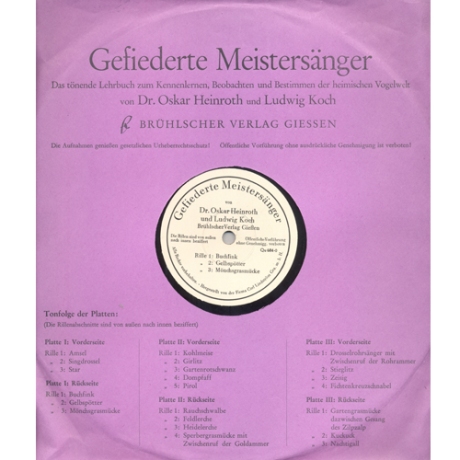
Ludwig Koch info at The Avibus Historiae

What Are The Roots That Clutch. MURMER
(Helen Scarsdale Agency 2012)
Review by Daniel Crokaert
How to associate sounds from different timbre & origins, and give them the strength & cohesion of the real capture while imparting them an increased value ?
How to extract the sound pith from listening experiences to re-inject it afterwards in a sort of still more eloquent aural form ?
Murmer gives magisterial answers to these questions : let those sounds mature, live with them for a long period since « What Are the Roots that Clutch » has been made on the basis of recordings collected along 4 years…
Infinite patience and an unquestionable ear for detail have indeed allowed Patrick McGinley, the walking listener, to avoid the trap of easy and hurried associations, and to reach a particularly refined level of perception where the roots of the sounds themselves seem to be exposed and recomposed in an abstract and terraced canvas of the most obsessive kind…
Here, no will of domination, only a way of slipping into the instant, of following a delicate figured out motion, of making the apology of stroking, of accompanying the concentric circles that inexorably move away from their impact point till fainting, blending in with the world… For, curiously, the raw capture, the instant fixation seems sometimes to fail there where sensitive transposition triumphs…
Sticking to its artist moniker, Murmer, Patrick McGinley suggests more than he imposes, handles the line in a one calligraphic go…the pieces slowly put together from ordinary sounds (bells tinklings, rain on objects, flows, cicada songs, voices, fences resonating like windharps…) become emancipated like as many independent looped vignettes, delivering an original and penetrating reading of our environment…
The form itself borders on hypnosis inviting our being to thrill in unison with…
A soak lesson where through open narrative, each one will find a grip and will come out of it expanded…an intricate music, falsely drowsy, a remedy against chronophagy… “What Are the Roots that Clutch” proposes new meaning and asserts itself like one of the crucial albums of 2012…
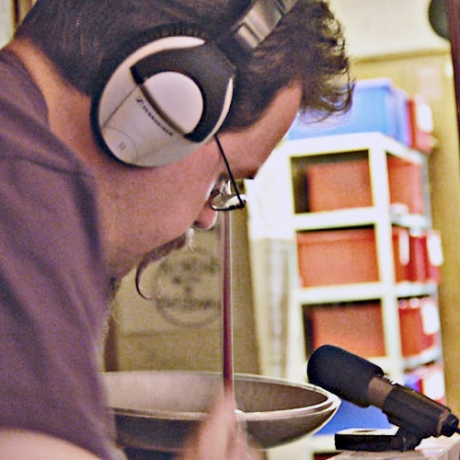
[Patrick McGinley -Murmer- photo courtesy of Sonikas]
- Translation to French-
Comment associer des sons de provenance, et de timbre différents et leur donner la force et la cohésion de la prise réelle tout en leur conférant une valeur augmentée ? Comment extraire des expériences d’écoute la moelle sonore afin d’ensuite la réinjecter dans une sorte de forme aurale encore plus éloquente ? Murmer donne à ses questions des réponses magistrales : laisser ces sons mûrir, vivre avec sur une longue période puisque “What Are the Roots that Clutch” a été réalisé sur base d’enregistrements collectés en 4 années… L’infinie patience et une incontestable oreille pour le détail ont en effet permis à Patrick McGinley, le promeneur écoutant, de déjouer le piège des associations faciles et hâtées, et d’atteindre un niveau de perception particulièrement affiné où les racines mêmes des sons semblent être exposées et recomposées en une toile étagée et abstraite des plus obsédantes…
Ici, pas de volonté de domination, de contrôle, juste une manière de se couler dans l’instant, de suivre un délicat mouvement décelé, de faire l’apologie du frôlement, d’accompagner les cercles concentriques qui inexorablement s’éloignent de leur point d’impact jusqu’à s’évanouir, faire corps avec le monde… Car, curieusement, la capture brute, la fixation instantanée semble parfois échouer là où la transposition sensible triomphe…
Adhérant à son nom d’artiste, Murmer, Patrick McGinley suggère plus qu’il n’impose, manie le trait en jet calligraphique…Les pièces lentement échafaudées à partir de sons courants (tintements de clochettes, pluie sur objets, écoulements, chants de cigales, voix, vibrations de clôtures métalliques…) s’émancipent comme autant de vignettes indépendantes bouclées sur elles-mêmes, offrant une lecture inédite et pénétrante de notre environnement… La forme, elle, confine éminemment à l’hypnose invitant notre être à vibrer de concert…
Une leçon d’imprégnation où au travers d’une narration ouverte, chacun trouvera accroche et en sortira grandi…une musique complexe, faussement engourdie, remède à la chronophagie… « What Are the Roots that Clutch » propose du sens nouveau et s’affirme comme un des albums cruciaux de 2012…
Patrick McGinley website
The Helen Scarsdale Agency website
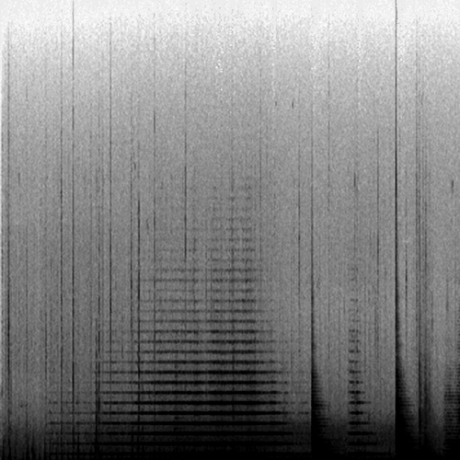
Parallel Paths. CELLO + LAPTOP -Edu Comelles & Sara Galán-
(Envelope Collective 2012)
Review by Jay-Dea Lopez
Parallel Paths is a collaborative release featuring Sara Galán on cello alongside the field recordings of Edu Comelles. Throughout the release the two sensitively weave around one another, exploring the relationship that exists between acoustic production and technology, melody and ambient sound, and interior and exterior space. The cello’s deep register forms the centre of Parallel Paths yet it is the field recordings that serve to distinguish each track, alternating between sounds recorded within the performance space and sounds of the sea.
Parallel Paths begins with an improvised performance that features recordings of footsteps echoing within (what might be) the performance space. The choice of field recording highlights the artifice of the ambience created. As the tracks progress the sounds of wind and the ocean replace those from the stage, the boundary between the interior performance site and the exterior world of field recordings becomes blurred.
“Remaining parts of a shipwreck” is the first track to move Parallel Paths into a different geographic space. As Galán plays the cello Comelles contributes to the piece with hydrophonic recordings. The splash of water as it passes across the surface of the hydrophones blends beautifully with the cello, the combination of sounds sparking our imagination. We listen visually, envisioning the story of sailors, a storm and an ensuing shipwreck from an unknown past.
“Shoreline” moves us from the water to an isolated windswept beach. Following the narrative of the previous track we can imagine the aftermath of the shipwreck. The cello plays long sustained notes, the whistling of the wind propelling the piece forward. The tone is solemn yet the juxtaposition of the field recordings and cello is so perfectly managed that we drift with its movements as if in a dream.
The intensity that develops during the course of “Shoreline” is pleasantly broken by a ship’s bell in “Wanderlust”. The bell’s crisp tone resonates with the aid of studio delay effects; it is in this track that the juxtaposition of field recordings and cello find themselves at their most ethereal.
“La souriante Madame Beudet” is the final track on Parallel Paths. The languid strokes of the cello play above Comelle’s airy processed sounds in what might be Parallel Path’s most filmic track. Although the title refers to a French silent movie about a loveless marriage there is still a nautical sensibility to the mood of the piece, with Galán’s cello undulating in the form of slow oceanic waves.
“Parallel Paths” is a stunning work, extending the possibilities of field recording and classical performance beyond their usual limitations. “Parallel Paths” is available for download in digital form, however those who buy the physical release are granted a free 23-minute track recorded live in Valencia. As we listen to Galán and Comelles we can only admire the way in which they listen to one another, their sensitivity towards each other infusing their work. The sounds and narratives of “Parallel Paths” resonate long after it reaches its end. We are left with dreams of oceans, windswept beaches, and sailors long forgotten.
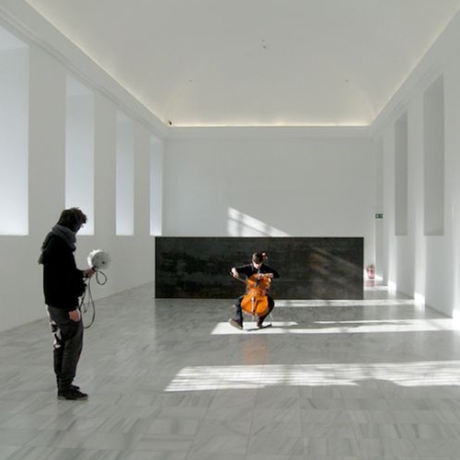
[Edu Comelles left, Sara Galán right]
Edu Comelles website
Envelope Collective website
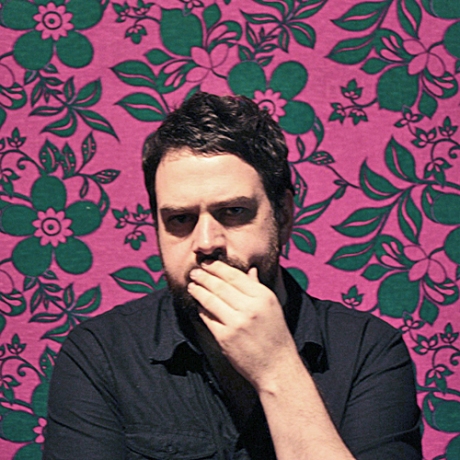
Interview with Francisco Meirino
by Chris Whitehead
Francisco Meirino lives in Lausanne, Switzerland and has been active in the field of experimental music since 1994. His work explores the tension between programmable material and the potential for its failure. He is fascinated by the idea of recording what is not normally deemed useful: The death of PA systems, gear failures, static, magnetic fields and electrical faults. He has collaborated with such artists as Dave Phillips, Mike Shiflet, Jason Kahn, Zbigniew Karkowski and ILIOS among others. Meirino has also worked with Michael Esposito, an expert in Electronic Voice Phenomena (EVP), in which human-sounding voices from an unknown source mysteriously appear on recording equipment. His latest release, ‘Untitled Phenomenas In Concrete’ was partly made using software developed by the composer Iannis Xenakis, which involves drawing waveforms and envelopes that are then rendered by the computer. To coincide with this release, Chris Whitehead interviewed Francisco Meirino in order to find out what forces shape his art.
-The Field Reporter
UNTITLED AND GRAPHICS
Q: Francisco, on your newest release ‘Untitled Phenomenas in Concrete’, you use an unusual piece of software devised by Xenakis?
A: Yes. As a “fan” of Xenakis I was at first really surprised by the UPIC idea, to “draw” sound. When I read more about his works, especially the polytopes and UPIC works, I decided to look in that direction, but of course, getting access to the real UPIC machine was very difficult. I tried many visual-to-sound softwares, like Methasynth, and did some max/msp patches, but nothing too fancy, or complex to really work with it.
I got more involved when the first version of HighC was made available. I did 85 of those HighC/UPIC sessions, from 12 to 480 seconds each.
Q: What does max/msp mean?
A: Max/msp is a unique and powerful software that allows you to create anything you want/imagine, either in sound or visual art, it’s very famous, very powerful but pretty hard to master.
Q: So the drawings on the poster that comes with the release are the score? That is what was fed into the computer programme?
A: No, the graphics designers, Xavier Robel & Eva Rittmer, did the reverse thing. They drew while listening to the record, to create a sort of mirror, like an answer to the whole CD concept. Some of the original drawings can be seen on my website. I did some videos where you can see and listen to them.
The label has a strong graphic line, very minimal, black and white. To use my original score was too complicated and I wanted them to listen and to do this process of mental drawing themselves, like any other listener. They did not see my score, only parts of it.
The visuals, are part of the concept. The graphic designers, the label and myself wanted to get the listener involved in the process of listening and watching at the same time, even if it was not the real score.
Q: I did that when I listened to the CD, because each section of Eva and Xavier’s graphics is given a time which correlates to the music.
A: That was the idea. I worked a lot on psycho-acoustic phenomena for this piece, I did a lot of stereo and sound positioning, because originally the HighC/UPIC is mono. It demands a lot of work and outer-space thinking to make it wide.
Q: How do you work with psycho-acoustic phenomena?
A: On studio records it’s maybe a bit easier because of the limitation of the CD or LP format, which is stereo, 2 channels.
So when mixing the tracks, a lot of work is done on the panning envelopes. I also work with a max/msp patch that I designed that allows me to add an extra dimension to the stereo position. It’s not only left and right, but it’s also high and low (in space-position) on each channel.
LIVE AND UNDETECTED
When playing live I calculate the room frequencies so that I can carefully choose which frequencies will produce psychoacoustics. I usually play with four speakers and four transducers to achieve that.
In the studio I use only crappy gear, old reel-to-reel recorders, broken oscillators, crappy microphones, etc., but I compose everything to 24 tracks on my computer. My live performances are mainly done by real time composition on 9 channels using sounds from my private audio library.
Q: That brings us nicely to ‘Undetected (untreated recordings from on-site testimonies archives)’ on the OtO label. Is that the kind of thing you use live?
A: Yes, I will use those kinds of sounds, but all together; snow recordings + static hiss from gear + sounds from field recordings, for example, to create a new composition.
Q: Some of those recordings from your archive are almost silent. I like that.
A: I like them too, but it’s the first time I dared to go in that direction. I mean I use silence as a composition tool, but my other records are far from silent..
I think that sometimes people use silence like a pause. I use it rather like a tool to make you aware of something else, of some other sound.
Q: Do you use silence in live performances?
A: No, I use dynamic changes, I mean near-silent, but always something. It might be tiny like those snow recordings on ‘Undetected’, but never complete silence.
Q: I like ‘Undetected’. The more I listen to it, the more I hear.
A: I’m glad you like it, and I’m very grateful to Takanobu Hoshino for putting it out. When I started my field recording blog, I never really thought it would interest anybody else.
I really enjoyed putting it together, and I can’t wait to see it available. Unfortunately the first pressing contained a mistake, but the re-pressing is on its way.
Q: Do you enjoy live work?
A: I have a complicated relation with it. I hate it as much as I love it, but as long as it’s in balance I’ll continue to do it. I don’t play much, maybe 20-25 times a year, but often I really enjoy it.
Sometimes I have mixed feelings about it though. I’m never totally happy with the concert. I have a serious problem with the idea of the artist being someone special that you come to see, the idea of artists having a “gift” or something like that.
I enjoy meeting people, to have them listen to my music in real time, to make them feel the sound, but I don’t like the idea of being a show-man. If possible I never play on stage, always amongst the audience, and even if I must play on stage for any reason, I usually go down with the audience to listen with them. I programme the next 2 minutes of the concert, draw the envelopes and then go down to join them.
I just hate the idea of putting people in different categories: Artist / Non-artist.
I know a lot of people who are creative, but don’t want to show it or share it. They are repressed by quality standards, or shame. I think anything can be good, like my Undetected CD. I think lot of people, even “artists”, will think that doing a CD with super simple sounds and acoustic phenomena is not art. I don’t, you don’t, we all have a different idea of what is or is not art.
It’s the eternal question of what is art.
DECAY AND LITERATURE
Q: Francisco, where did those squid come from that are on the cover of A While and Awhile?
A: Oh, the squid? It’s a picture I took in Shanghai, in the old (now destroyed) Museum of Natural History. Everything was rotten or in bad shape there, my personal heaven.
I’m working on a book, my second actually, with pictures from this museum and field recordings from Shanghai.
Q: Your first book was ‘Transduce’?
A: Yes, ‘Transduce’ was my first book. I only did 50 copies, I didn’t think it would be sold out that quickly! I wanted to do a book for a long time. I don’t really write essays or anything like that, but I do keep notes on dreams, ideas, concepts etc…
Q: What sort of dreams do you have?
A: I sleep only 4-5 hours each night. I don’t remember so many of my dreams, only the weird ones, but I do write a lot in a half-asleep state, do you know the record I made under my old moniker phroq called ‘half-asleep music’ ? It was an audio document of this, many of my album titles or tracks come from these ‘half-asleep’ notebooks.
Q: Do you write poetry?
A: No, I don’t think so. My girlfriend says that ‘Transduce’ is a poetry book, I don’t know… I did this book and I did with words what I do with sound, assemble, destroy, awkward moments, purity of the process, etc..
Q: Looks like poetry to me. Once again, like art, poetry is also hard to define.
A: Yes, totally, I’m a librarian part time, my field of work is children’s books and comic books, I love books, I’m not a huge poetry reader, even if I one of my favourite authors is a poet, Beckett.
DIY AND COLLABORATING
Q: I understand you make your own equipment and instruments?
A: Yes I do, I make my own contact microphones and light-controlled oscillators. I also did a lot of max/msp, but I am pretty bad at all of this. It’s more that I can’t find the gear I want, and when I find it the sound is too ‘clear’, too ‘perfect’ for my taste. My own oscillators are so badly done that they have the sound quality that I like.
Q: That explains your unique sound. I love that. I am terrible at making contact mics. They always buzz and hum like bees
A: Yeah, well that’s what I like, when you build your own mics. Firstly they’re cheap, secondly they all sound different, and you can adapt them to your needs.
I build a contact mic with a strong magnet and a 5 metre cable that I can throw over barriers at constructions sites, the magnet will stick to any metal pipes then I’m ready for some recording.
One of the tracks on ‘Undetected’ was done with this homemade magnetic contact microphone. The scaffolding was around my house for about 8 months. I did a lot of recordings, by day, by night, I will use some to make a record with ILIOS.
I have 2 LPs coming in 2013 and a CD re-issue of my 2010 album ‘Recordings of Voltage Errors.’. Also some collaborations, and I think the book will be ready for the end of 2013.
Q: I was going to ask about collaborations, such as the one with Dave Phillips. How do they work?
A: Most of my collaborations are done by meeting with the other person and recording something over a long period. The album I made with Dave was really a studio album. We met many times over five years at my home studio to record, days and days.
With Mike Shiflet we met in his hotel room, got drunk and recorded like in a live situation. With Jason Kahn we recorded live in an empty cinema then we edited the recordings together. It’s very unique every time.
EVP AND THE BLACK CASE
Q: Where do EVP come from?
A: That’s the question! For some they come from the beyond, the voices of the dead, for me they are more the “proof” of the persistence of energy.
Ii just curated a day’s workshop with EVP expert Michael Esposito last week. We also performed live together last Saturday.
Q: Are the EVP real?
A: Yes, EVP stands for Electronic Voice Phenomena, it is as real as electro-magnetism. For the workshop we recorded with the students in my library where the source material for our CD was recorded, so they could witness that no one was speaking when we later found some voices hidden in the recordings.
Q: Does Michael Esposito think they are the spirits of the dead?
A: Yes, I think he does, but not in a spooky way, more as a trail of energy of the soul.
He says they are like when our body dies, all the energy in it does not disappear, energy is kinetic, it becomes nano-small but never disappears. He will use the image that our body is a flashdrive. If you destroy that flashdrive, you will still be able, with the right tools, to retrieve information.
He also relates it to phantom organs. If you lose your arm, you will still feel it, in some cases, its energy field will still be present, why ?
I really do not believe in ghosts, but when I face a phenomenon like that it makes me curious.
Q: Finally I must ask about the black suitcase in the photo. What is the machine with 11 knobs on?
A: It’s my gear for my “no laptop” live sets. I sometimes do analog sets, but only in Switzerland. The thing with 11 knobs is an analog synth/filter from Trogotronics.
There are tons of cables because my analog set-up is 12 track based. Analog synth + contact mics + reel-to-reel recorder + 4 home made light sensitive oscillators + magnetic field detectors + 12 channels mixer. It’s pretty heavy to carry.
Q: What if all those black cables crawl out and wrap around you one dark night?
A: If they do that, well at first I’ll be surprised, then probably dead. Let’s hope that I will be able to communicate with you through EVP then!

Francisco Meirino website
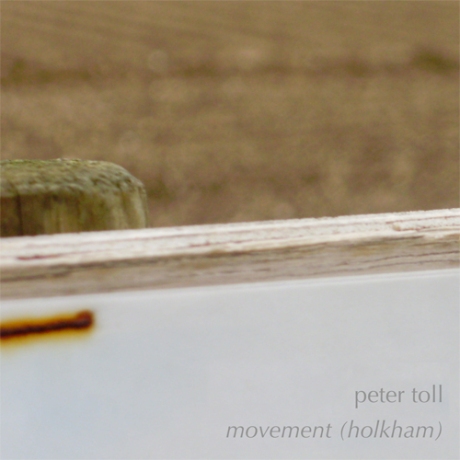
Movement -Holkham-. PETER TOLL
(Engraved Glass 2012)
Review by Cheryl Tipp
Listening to a publication for the first time always comes with a sense of anticipation. How will it sound? What form will it take? Will it match my preconceived ideas or will it surprise? Will I like it? Right from the start I knew that Peter Toll’s ‘Movement (Holkham)’ would not disappoint. This lovely release from Jez riley French’s Engraved Glass label comprises two compositions which have been built from a series of field recordings made in the Norfolk village of Holkham, England. These recordings, made during the winter months of two consecutive years, introduce some of the habitats that make up the Holkham Estate which include grazing marshes, a country hall, pinewoods and even a beach. Toll writes:
“For this album I tried to record the natural, wildlife setting of some of these habitats with as little interference from humankind as possible. I wanted the listener to feel that he/she is floating in time & space. Pausing at each different location, quietly listening to the wildlife and energy of each position, before gently moving on to the next”
This short paragraph perfectly sums up the spirit of ‘Movement (Holkham)’. Feeling more like a relaxed ramble than a whistlestop tour, the listener is not rushed through each habitat; enough time is given to immerse oneself in the soundscape, pay attention to the variety of sounds found within it, enjoy the act of listening and then move forward to the next segment. The pace is relaxed and the whole journey is a seamless transition from one habitat to the next.
‘Movement (Holkham)#1’ is the longer of the two compositions and includes some really brilliant field recordings. Beginning with a cold autumn night in the grounds of Holkham Hall, the crisp air is filled with hooting Tawny Owls alongside the movements and calls of Fallow Deer. The detail here is fantastic, with delicate rustlings through the leaf litter sitting effortlessly next to the deep resonating calls of Fallow bucks. Quiet descends as we then move into that undefined space: Edgelands. Somewhere between a marsh and a wood we are able to eavesdrop on the comings and goings of the nocturnal inhabitants of this area. Distant Muntjac, squeaking shrews, a calling Tawny Owl and vocalising geese all contribute. ‘Geese at Dawn’, the third section of this piece, summons images of an awakening landscape. The brash calls of Pink-footed Geese gradually swell into an overwhelming cacophony as the flock takes to the sky. Finally, as night becomes day, the sonic landscape shifts. Calling tits, a crowing pheasant, mooing cattle and a strident Wren come together to create this final scene.
The second movement, ‘Movement (Holkham)#2’ comprises just two recordings, both of which covey a sense of expansiveness. A strong, gusting wind through lofty pine trees is accompanied by gentle creaks and crisp flecks of sound as the trees begin to lose their seeds. Then we are enveloped by the sounds of the North Sea crashing onto the Norfolk coast, both above and beneath the surface.
Aside from admiring the technical quality and compositional structure of this publication, I feel a real fondness for ‘Movement (Holkham)’, probably because it represents the sounds of home. I’m not from Norfolk, nor do I reside there, but these recordings speak of the natural England which I and many others cherish.
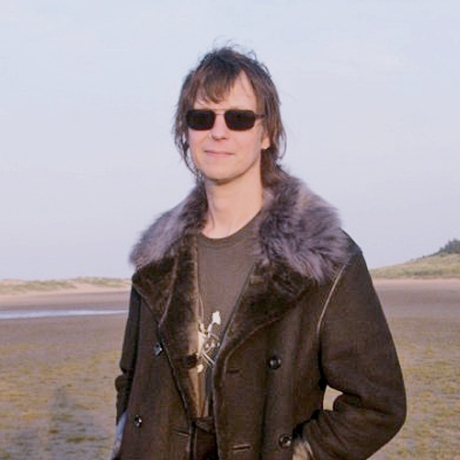
[Peter Toll]
Peter Toll website
Engraved Glass website
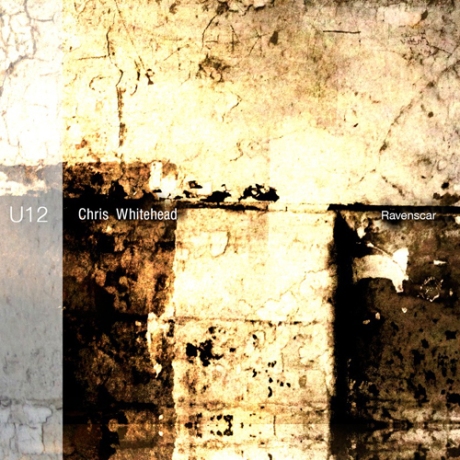
Ravenscar. CHRIS WHITEHEAD
(Unfathomless 2012)
Review by John McEnroe
2012 has been a very succesful and prolific year for Chris Whitehead with releases like ‘Gryphaea’, South gare’, Ravenscar’ and recently
‘Ch – da ( d – 2 )’ with Darius Ciuta.
This time I will focus on ‘Ravenscar’ published by Unfathomless one of the most active and relevant labels on the musique concrete line.
In the beginning ‘Ravenscar’ presents us the sea, the roaring and loud waves of the ocean…later some ‘tactile sounds’ appear and merge with the waves sounds.
By ‘tactile sounds’ I mean sound explored on a magnifying approach where the textures, friction and the smallest movements are amplified.
I say tactile approach because this is probably done with contact microphones that capture the sound that propagates through solids through a membrane that is placed on the surface. I have the notion that the artist is particularly fond on looking for the detail in materials like wood, stone and concrete where he explores their textural and other material aspects through a micro approach. These tactile sounds are something Chris Whitehead is a master of: whether he uses only contact microphones or air microphones pointing to small events, this is a characteristic formal aspect of his work that again on ‘Ravenscar’ is greatly instrumented.
When Chris Whitehead juxtaposes the sea waves and the magnifying sounds I personally feel like we are listening simultaneously to the roaring surface of the sea and all the tiny small movement occurring underwater on the often quite ground of the sea. What a poetic, strong and beautiful analogy.
When the sea waves sounds start to fade we are left to this micro universe where wood and stones and other material ‘play’ in a very organic way: whether this is done in the style of Foley or capturing natural incidental processes, these sonorities present an enormous formal value that the listener could fully enjoy.
The sounds of water in their different manifestations are greatly instrumented by the artist along ‘Ravenscar’ where he explores their different acoustic properties from the sounds of the overwhelming sea waves to the sounds of small creeks and little dripping. Water presents always this biological implication of being the origin and sustain of life and this is something we can’t escape from. In this case water functions like a narrative linking element that connects the different fragments of the piece.
Through the beginning of the second third of the piece something dark starts to arise with a series of droning sounds and guttural birdsongs that are combined with repetitive sounds that brings the work to a very intense point that kicks out like a perception-altering drug. Here the listener is put near the boundaries of his comfort zone where enjoyment and repulsion convey; the levels of acoustic intensity here reminds me of the sound design of the Alejandro Jodorowski movies where sound is explored on its eeriest, more intense and harshest facet.
The intensity levels gradually fades through the middle of the piece until grave drones take over while he can simultaneously listen to the sounds of dripping water inside some sort of cave or a similar structure. This is like being in the outer space and the city’s sewage system at the same time. This long fragment is probably the most significative for me as this is where the cosmological aspect is better instrumented putting the listener into some kind of trip where we are confined to the depths of his persona.
After this beautiful sequence the releases enters a territory where droning sounds, tactile sounds, processed material and quotidian sounds are juxtaposed building a strong emotional atmosphere where the sound images bring to live something potentially scary and yet strongly beautiful that somehow never fully develops…later the sounds of wind emerges to clean it all out.
The wind fades to the sounds of bleeps and the droning sonorities of an airplane.
Then it all ends.
‘Ravenscar’ is a really carefully and thoughtful composed piece -yet very emotional and open- where the structure on time and depth is taken advantage of to its fullest. Here we are confronted to the cosmological and the quotidian, we are confronted to to the magnitude of the universe addressed in both its immensity and its detailed and infinite complexity.
To review ‘Ravenscar’ brings the Michael Chion idea that films are in a way sound art pieces, but on the other way around: ‘Ravenscar’ narratively and psychologically works like a film in terms of the use of the time line and images similar to sci-fi movies like Andrei Tarkowski’s Stalker or Solyaris where we go through an inner trip of obvious-cosmological character that takes place in nature zones and urban areas, places that are, after all, built on star dust.

[Chris Whitehead]
Chris Whitehead website
Unfathomless website
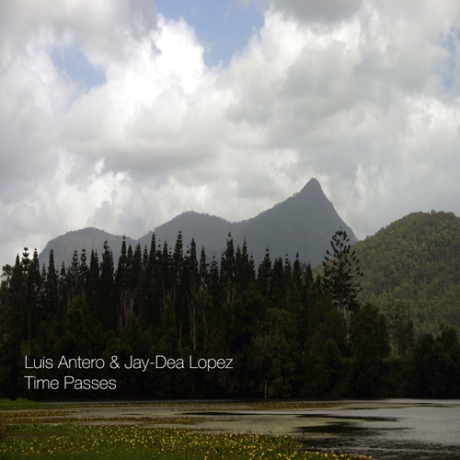
Time Passes. LUIS ANTERO, JAY-DEA LOPEZ
(Green Field 2012)
Review by Flavien Gillié
A Day In The Life
Jay-Dea Lopez et Luis Antero artistes sonores et adeptes du field recording sont réunis ici sur un album pour littéralement faire passer le temps, au sens noble du terme, reconstituer une journée, 24 heures, ou plutôt ici 24 minutes, mais ô combien luxuriantes.
Tout est question d’écho, d’unité de lieu, Luis dans son studio Jay-Dea dans la forêt sub-tropicale d’Australie. Chacun va se mettre au service d’un incroyable flux sonore, s’employer à faire foisonnement, réinventer la vie, celle d’une forêt dans un studio, et pourquoi pas aux antipodes faire de la forêt l’intimité d’un studio.
On oppose souvent, par manque de vocabulaire voire par volonté réductrice, le field recording au studio recording, le dedans et le dehors.
Ici rien n’est opposition, la symbiose est parfaite, bien malin qui saura démêler l’entrelac des nappes et des frottements de mandibules, tout crisse, tout vit, luxuriance et pâmoison d’un temps qui passe sans compter, une journée heureuse en quelque sorte, et si le soir préfigure la mort, alors on veut bien s’y rendre de cette manière, en toute quiétude.

- Translation to English * -
Jay-Dea Lopez and Luis Antero, sound artists and field recording votaries, unite here on an album to litterally pass the time, in the noblest sense of this expression, rebuild a day, 24 hours, or rather here, 24 so lush minutes.
All is about echo, space unity, Luis in his studio, Jay-Dea in some australian subtropical forest. Each is willing to serve an incredible sound flux, involved in creating profusion, reinvent life, the one of a forest in a studio, and why not, at the antipodes, make the forest the intimacy of a studio.
One often opposes, either by lack of vocabulary or by simplistic will, field and studio recordings, the inside and the outside.
Here none is about opposition, symbiosis is perfect, how clever the one how will untangle the tracery of sound layers and mandible frictions, everything scrapes, everything lives, luxuriance and swoon of time passing without mattering, an happy day, in some sort, and if the evening announces death, one is willing to reach it this way, in a peaceful manner.
*by Sismophone
Luis Antero website
Jay-Dea Lopez’ Sounds Like Noise website
Green Field website

The Field Reporter Radio #13
programmed by Alan Smithee
.
.
1. (fragment) Part 4. MURMER from ‘What are the roots that clutch’ (Helen Scarsdale Agency 2012)
2. (fragment) To Ostatnia Niedziela. ARTURAS BUMSTEINAS from ‘Ostatnia Niedziela’ (Echomusic 2012)
3. The Wide-Eyed Love That Dribbles Tears Down Dusted Cheeks. CHRISTOPHER McFALL from ‘Disengaged Songs for Disenchanted Lovers’ (Mandorla 2012)
4. (fragment) Portrait 2. ROLAND ETZIN from ‘TransMongolian’ (Gruenrekorder 2012)
5. (fragment) Pneuma II. SETH COOKE from ‘Pneuma’ (NA)
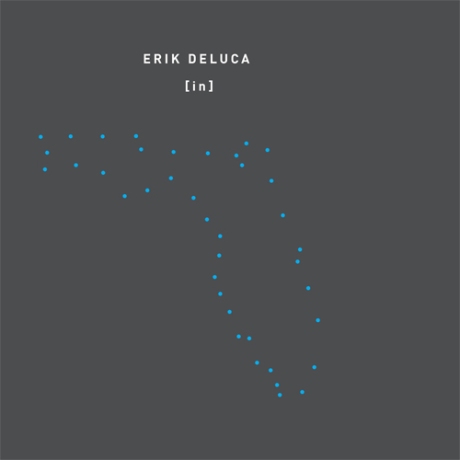
[in]. ERIK DeLUCA
(Everglade 2010)
Review by John McEnroe
I have heard and reviewed a variety of hydrophone recordings-based releases through the past two years and it amazes me how artistic experimentation and research can lead to new and surprising results.
[in] is a 2010 release by Florida based artist Erik DeLuca published by Everglade the label that published [re] by Stephen Vitiello in collaboration with Benjamin Broening, Mark Applebaum, John Gibson and Larry Polansky back on on 2006.
[in] is a 40-minute release composed by 9 individual pieces, a format that works quite well for the different individual tracks and for the totality of the work.
On an initial listen one the aspects that I found most interesting here is how the sufrace sounds captured with the hydrophones blend with the underwater sounds, presenting a notion of inside-outside that puts the listener on a very ambiguous and ever-changing place.
On a further listen an aspect that is very relevant is that DeLuca purposely on indadvertedly focused on two kind of sounds: First the sounds produced by a variety of animal species such as crustaceans, fishes, dolphins and snails, and second the sounds of boats and even a cruise ship. It’s impossible not to find a political sense on this formal considerations: we have the animals in one side and the human machinery on the other but we also have them together in some sort of complex coexistence. The effects of human intervention in nature-prevailing environments reflects on a variety of biological aspects that have an echoe in the acoustic end: this echo is what DeLuca successfully and pertinently addressed with his recordings.
The two kind of sounds that the release seems to work around, are captured on a noteworthy manner as they seem to occur way in the foreground: we hear them in such detailed way that we can perceive every little aspect of them in terms of their shapes, textures, friction and movement. This helps for the the listener to be transported to a universe where scales and densities sound in a way they don’t sound like on quotidian listening; the change in the way things sound like derives after a few minutes into a change in the way we perceive things and this is the magic of this release: the capacity to generate in the listener a momentarily change of perception beyond any rational and technical factors.
The political aspect emerges strongly at the end of the release when in 9 the loud and harsh sound of a cruise ship enters the scene to finally fade out. I could say this was articulated as some sort of cautionary tale that warns that doom and gloom awaits for us at the end of the vector line that the technological notion of progress is drawing.
The political and perceptual aspects of this release makes it a very successful one that also rewards the listener with a very compelling formal and aesthetic experience.

[Erik DeLuca]
Erik DeLuca website
Everglade website
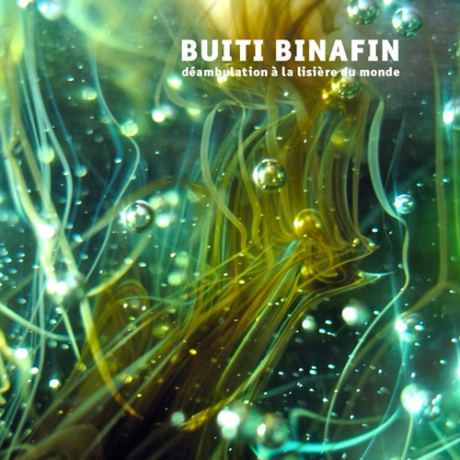
Buiti Binafin. FRÉDÉRIC NOGRAY
(3Leaves 2012)
Review by John McEnroe
Some times I want to listen to the sounds of the rain forest. Sometimes it’s be the best I can do to be fully or acousmatically transported away from the quotidian sounds that just potentialize the often boring and stressful character of my every day existence.
The cars, my house, people talking, the TV, the telephone…
Through the last three months I visited forest areas near my city way more often than usual. It becomes an incredible experience to be by yourself in the middle of all this nature, quietly listening to this multitude of sounds forcing the perception to multiple focus and finding some pleasure and meaning on that.
On the quest to visit the rain forest while in my house in the middle of a concrete jungle I found ’Buiti Binafin’ which immediately managed to transport me there. This is truly one of the potentials of field recording based music, the potential to transport the listener somewhere else whether it’s to the Antartica or to a shoes factory.
By recording the rain forest and the vast bio-diversity found there, the artist is addressing the power of nature in terms of is complexity. By playing back this recordings he plays the role of a distorting medium, a messenger of an ever- fading message. In a way the artist always mimics the nature but he is only successful when he ‘becomes’ the nature, when he finds ways to mimic the nature as a power, as a vector of strength and magnitude.
Why would the artist try to act as he was the nature?
Because only the nature and its forces helps establishing the sense of immeasurable magnitude and incompressible complexity that derive in an emotion we can refer to as the sublime.
The sublime seems to be an emotion that triggers many phonographic based works. This contact with the magnitude and power of the nature leaves a track, a void that the sound artist fills with his memory imprinted on the tape or the memory card.
In despite of its phonographic character the listener could ponder the artist’s craft in ‘Buiti Binafin’ at least through the fact that there is a rational and emotional structure throughout the work: the pice starts with loud sound of waves that later return through the end. All across the lengthy middle the listener enters a long fragment where he could hear mostly sounds made by animals. The artist’s craft can also be sensed on what seems like juxtaposition of sounds on some fragments of the release.
The formal results in ‘Buiti Binafin’ are quite compelling, the sounds are fully believable and the whole emotional atmosphere he manages to build has this ‘sublime’ character that sets up a scenario for sensible and intellectual craving.
In regard of the question ‘to edit and juxtapose or not to’ in phonographic based composition some can say who cares, but for some artists it can be a puzzling question.
The line that divides documental phonography and music concrete can be rather blur for the listener. Anyway the intention to document and the intention to manipulate material are very different.
Frédéric Nogray seems to have found a balanced point here: the listener can sense the derive and natural order of things. But when the edition is visible we can tell there is something he wants to say or point out to. Personally I think he is interested in the power of nature depicted in contrast: movement and the stillness, violence and the calm, harmony and the noise.
When one reads the ‘Buiti Binafin’ liner notes one can tell Frédéric Nogray spend long hours in the the jungle probably being very quiet while watching the nature do its thing. His role here exemplifies the role of the artist who feels that being a medium is ethically his only choice.
Then when he returned home, the forest stopped being the subject, now his experience, his memories of the forest became the subject, and in this process he also turns from being a quiet observer to be the action himself. He becomes ‘the creator’, he becomes a force in the universe.
‘Buiti Binafin’ puts on the table the metaphoric character of recording sounds as a way to capture time. Recordings sounds is a useless and yet essential exercise in order to poetically deal with the ineffable character of the universe and the emotional meaning we get when we have an experience with it.
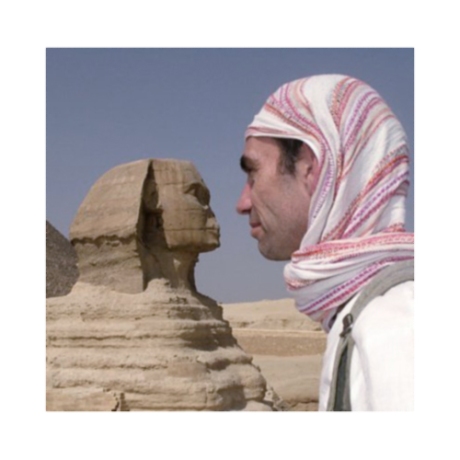
[Frederic Nogray]
Frédéric Nogray website
3Leaves website

Interview with David Michael
Interview by Chris Whitehead
‘The slaughter house’ is a controversial phonographic release composed by sound artist David Michael and published by german label Gruenrekorder. On this work the artist captured sounds on a slaughterhouse in Alabama which on an initial sight could be a rather difficult subject to address in terms of the ethical and moral aspects involved. Intrigued by this release, our editor Chris Whitehead interviewed the artist about this work and here we have the answers. We would like to thank David Michael for his time and interest in our questions.
-Alan Smithee
Q (Chris Whitehead). From what point of view did you set out to record Slaughterhouse?
A (David Michael). Originally I was interested in making a ‘nature recording’, but from the perspective of a part of nature that is typically ignored in the genre, specifically themes of death and the like. Much of the time all you hear is lush springtime choruses, ultra-quiet idyllic soundscapes, life in full bloom.
Q. It begins with birds.
A. It does – I suppose I was trying, not too subtly, to set the contrast.
Q. It also ends with going back to nature.
A. This decision was perhaps more compositional. It was actually how my own experience there ended (and began for that matter), but it also ties together the record – idyllic nature on either side of dismemberment.
Q. I notice there are no pictures in the packaging.
A. I was told very specifically that I was not allowed to photograph or video. The owners and butchers were deeply paranoid about PETA showing up and giving them grief. Apparently it had happened before. They thought that any pictures would lead PETA or other activists right to their door, so I didn’t take any.
Q. Why did they agree for you to record then? Was a lot of persuasion involved?
A. There was very little persuasion, I called up the establishment and talked with the owner who said I could record. It really was that simple.
Q. Was it difficult to watch?
A. At first yes, but it’s not shocking. It’s natural, like having a baby or something like that. It makes me think about when my son was born – seeing him for the first time – it was like “oh yeah, of course”.
As far as I can tell, ‘slaughter’ is as old as human civilization itself. On a deeper level, all carnivores kill, and while humans are not strictly carnivores, we are certainly part of this system of devouring other living things.
Q. It didn’t put you off meat?
A. Not at all, in fact we went out to lunch mid-day for a BBQ. It’s not because we are totally insensitive, it’s because that’s what people do. Well, not all of us, obviously.
Q. During the recording you say the line between life and death is fuzzy. I found that intriguing.
A. Me too! They disagreed with me, but the cow (which they called ‘beef’) was still alive in many ways. It was not consciously alive as the bullet to the brain knocked out that system, but the other systems were still mildly functional. The heart still beat until there was no more blood.
Q. Kind of electrical muscular activity?
A. Oh definitely. The muscles twitched, skin shook, the systems were not working well together any more, but much of the animal was still alive, and I assume remained so until the freezer.
Q. There’s a bit where the guy says ‘don’t get brave and step in there will you?’, and you go ‘absolutely not’.
A. Yeah, he warned me that after they put down an animal it still can get violent and kick and whatnot. I had approached her really close after he shot her, which really agitated him. I think he saw it as disrespectful, which in hindsight it probably was.
Q. To whom?
A. The animal.
Q. I can’t quite grasp the relationship between the men and the animals?
A. I can’t either. The father seemed less conflicted about it, less analytical. I actually think that the young man’s faith led him to some hard internal questions. He told me stories about how others in the community had called him a murderer. These are folks at his church, but this was his family’s profession, for better or worse. It’s not like there are loads of job options in this area and honestly, i don’t know that he wanted to do anything else. He was very good at this job, he was trained by his father.
Q. The religion, the blood and the death conjour up a gothic atmosphere, or is that too simplistic?
A. Not simplistic at all. One of the aspects of this recording that I had not bargained for is that it is so sparse. The process is almost entirely visual, really the only thing that is left for the listener is their own mind. The religious aspects were completely unplanned. I had no idea the young man would be so devout – evangelical even. The other thing I came to realize is that for these men, this is a daily affair.
Q. There is a lot of hosing down of hard surfaces.
A. Yes, there was a lot of blood, fluid, dirt and excrement. The hose is essential in cleaning up the beef. The animals very literally just arrive from the field with all the earthly contamination you might expect. Customers would drive them up in trailers.
During the day they slaughtered 2 animals, a cow and a young buffalo, both females. I was not allowed to watch them putting the buffalo down. They used a very high powered gun and the owner didn’t want me around.
Q. Do we hear the buffalo shot as you walk away on the last track?
A. Yep – that’s the one. That one actually really freaked me out. I think it was not being able to see what was happening that made it different, but after they shot the buffalo I found myself really shaken.
When it’s something you are involved in, it’s rational, it’s natural. When you are not involved, it’s execution. This may be like anything – when you are a part of something, you can rationalize it. When you are not a part of it, you critique it – in this case I can see how it’s easy to get activist about slaughter when you have not been a part of it. I actually don’t have a position on the morality of eating meat.
Q. So should listeners file this under nature recordings?
A. I find it surprising that anyone would listen to it at all, in fact, I feel like the idea of the recording is enough – I could probably have left it as a conceptual piece. I think you will find that the nature recordists would squarely reject this as a nature recording, which is fine. The content is not really in line with the genre, though the inspiration for the recording was directly from the genre.
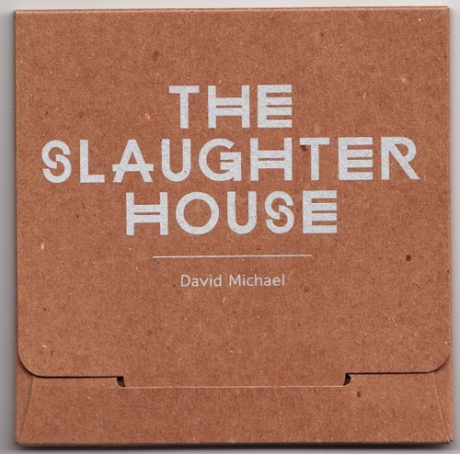
[David Michael photo courtesy of Impulsive Habitat]
David Michael website
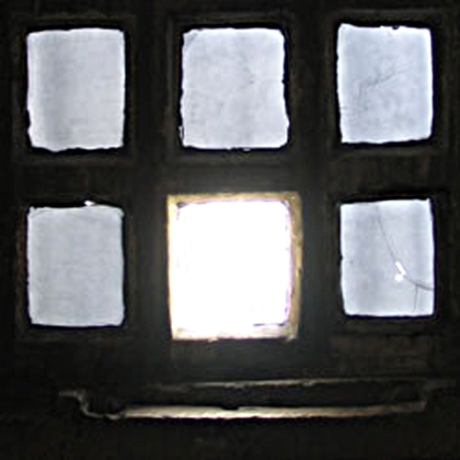
Sacralizing space. MATTHEW SANSOM
(Wandering Ear 2006)
Review by Jay-Dea Lopez
The sounds of seabirds, wind and distant traffic suggest we are positioned at a coastal region, a liminal point where nature meets the urban sprawl. The tranquillity is broken by a man’s voice. Through surrounding public speakers he sings the adhãn (the Islamic call to prayer). We are in Turkey, seated outside the Sultan Ahmed Mosque, colloquially referred to as Istanbul’s Blue Mosque. Completed in 1616 it is said to be the last great mosque of the Ottoman classical period, standing at 45 metres high with 6 minarets, 7 domes, and with an interior of 20,000 tiles. In this thought-provoking release Matthew Sansom explores the resonance of Islamic sacred music within this architectural space.
By the time the adhãn finishes we have an insight into the Blue Mosque’s physical and spiritual domination of Istanbul. Sansom then places his microphone inside the Blue Mosque for the second track. With the sounds of the external world behind us we settle inside for the Fajr (dawn prayer). The immense interior houses impressive acoustic qualities. As we wait for the Fajr to begin footsteps and coughs echo from wall to wall. When the muezzin finally begins his powerful voice reverberates throughout the mosque, creating a sense of otherworldliness. The muezzin’s voice is sombre and without any instrumental accompaniment, the pace of the melody is slow and measured. It is a perfect antidote to the bustle of the secular world as the combination of voice, melody, and acoustics produce a meditative stilling of the mind.
Listening to Sansom’s recordings raises some interesting points concerning the way we use and listen to sound in religion. Each of the world’s major religions enact sonic rituals in an attempt to remove followers from their earthbound distractions. Examples include the singing of Gregorian Chants in Christianity, the nigun-rounds in Judaism, group chanting in Buddhism. By transposing prayers into melodic compositions followers can enunciate words in a more heartfelt and sincere way, raising the sacred texts beyond the page.
“Sacralizing Space” features the sacred music of Islam however the employment of sound to enrich and transmit spiritual ideals is a common religious practise. Although we may not understand the language in which the prayers are sung, or for that matter share the same religion, it is difficult to remain unmoved by their melodic and tonal qualities. By engaging with the sacred music of others we broaden our sense of cultural sensitivity, a necessity in this era of globalisation. In this context Sansom’s field recordings demonstrate the value of listening openly to the cultures that surround us.

[Blue Mosque at Istanbul, courtesy of Famous Wonders of the World]
Matthew Sansom website
Wandering Ear website
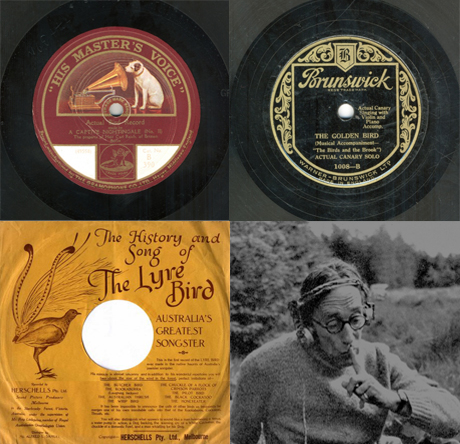
The Birth of Wildlife Sound Recording
Research by Cheryl Tipp
For our 191th post we publish the entire research text written by our editor Cheryl Tipp (Wildlife Sounds Curator at the British Library) for our journal in regard of the origins of wildlife sound recordings that was published in five volumes earlier this year.
PART I
Ludwig Koch is described as the father of wildlife sound recording and is arguably the greatest pioneer in this field. He made the first ever recording of a bird in 1889, at the tender age of eight, when his father brought home an Edison Phonograph and a box of cylinders. The subject of Koch’s experiment was his pet Indian Shama, a species whose rich, melodious song made it a popular cage bird. Koch would go on to play a significant role in the development of wildlife sound recording, but the credit for producing the first ever commercial wildlife recording would go to fellow German, Carl Reich.
In 1910 the German branch of the Gramophone Company released ‘Actual Bird Record made by a Captive Nightingale’. The list of new records published by the Gramophone Co. Ltd in August 1910 described the recorded Nightingale as being a famed songster that was “taken about through Germany by its proud possessor for show purposes”. The bird in question belonged to canary breeder and bird collector, Carl Reich, who kept an aviary in Bremen, Germany and was to have a recording career that spanned almost thirty years. Eight separate recordings of the Nightingale were collected by audio engineer Max Hampe, who had travelled to Reich’s base in May 1910 to conduct this acoustic experiment. Each recording was originally released in Germany in single-sided form and copies were soon available in many European countries, including the United Kingdom, as well as the USA, Russia and even Australia (Figure 1).
The Gramophone Co. Ltd actually explained the recording process in their list of 1910, which reinforces the significance of this recording achievement. According to the promotional passage, “The cage was suspended in front of the horn, and as soon as the recording motor was set in motion, the bird began singing and did not stop when it should, as will be seen by the last note of the record, which clearly shows the bird went on singing after the instrument stopped recording.”
Reich was to dominate the commercial arm of wildlife sound recording for the next decade, with further recordings of singing Nightingales being released in 1912. The scope of this publishing programme was then widened and other birds in Reich’s collection were recorded. Successful takes were published by the Gramophone Company and Zonophone, with titles such as ‘Actual Bird Record made by a Captive Thrush’ (1913) and ‘Duet: Mock Nightingale, Garden Warbler’ (1926) being released in several countries.
The birds of Reich’s recordings were all chosen based on their reputation as versatile and talented songsters. Species such as the Nightingale, Blackbird and Domestic Canary are renowned for their sustained singing bouts and the variation, tonal quality and frequency of these songs would clearly make these popular recording subjects for both the engineers charged with recording the songs and the public listener.
For the first time ever, people could listen to a recording of an actual bird, albeit a captive one, from the comfort of their own home. This moment signified the birth of a completely new variety of sound recording for the commercial market and presented a fresh way of appreciating wildlife. No longer did the natural history hobbyist have to make do with a collection of monographs, illustrations or inanimate specimens. Sound recordings of wildlife had now come onto the scene and there was to be no looking back.
PART II
Recording in the Wild
Cherry Kearton was responsible for the first recordings of wild birds when he captured the song of a Nightingale and a few phrases from a Song Thrush in England in 1900.
The first commercial recordings of a wild animal came about, not through the tireless work of a naturalist, but through the suggestion of a musician. Beatrice Harrison was a respected British cellist who had made broadcasting history in 1924 when the sounds of her playing alongside a wild Nightingale in Oxted, Surrey were transmitted live by the BBC. Harrison believed the Nightingales were stimulated by the sound of her cello and the popularity of this first broadcast led to several similar programmes being made over the next few years. The Gramophone Company agreed to publish a selection of pieces featuring Beatrice Harrison with “her” Nightingales and in May 1927 the label’s mobile van recorded what would become five double-sided discs that were widely circulated around the world. We will never know whether the birds were encouraged to sing by Harrison’s cello or were simply delivering their musical messages at times of the day when they would be most vocally active anyway. What we do know is that these recordings represent another key landmark in the history of wildlife sound recording.
Novelty Acts and Canary Choirs
The tradition of keeping canaries as cage birds is a long one. Their strong, varied songs and penchant for imitation made them extremely desirable as pets. The German canary trade was one of the most respected in Europe and birds reared in Germany were highly sort after. Richard Avis said in his book of 1872, ‘The Canary: its history, varieties, management, and breeding, “The Germans, who care little for either the form or colour of their birds, pay great attention to their song and we advise all those who wish to fully develop the good qualities of young canaries to place them under the tuition of a German bird.”
Carl Reich kept canaries in his Bremen aviary and several of these birds were recorded for publication. In some cases, the canary recordings were combined with folk songs and these records from the late 1920s represent some of the earliest examples of fusion between music and wildlife recordings for the commercial market.
Musical Dawson’s Famous Choir of Canaries became the star ingredient of eleven records released in the UK from 1932 – 1933. Dawson’s singing canaries were recorded and then mixed with a pre-recorded small orchestra to create unique versions of ‘The Blue Danube’, ‘O Sole Mio’ and ‘Tales of Hoffman’ among others. A wonderful British Pathé newsreel film from 1938 showed Musical Dawson accompanied by a choir of nine caged canaries while he played ‘In a Monastary Garden’.
In the USA, Lorraine Evon & The Golden Bird became a popular Vaudeville act in the 1920s. A photograph of the young Miss Evon posing with the canary perched on the end of her violin can be found in the photographic collection of the drama critic and theatre promoter James Willis Sayre, who collected images of stars performing in Seattle from around 1900 to 1955. Brunswick released a double-sided record of the duo in 1930, which featured ‘The Canary Polka’ and ‘The Birds and the Brook’ (Figure 2).
An equivalent music hall act in Britain was The Auklands and Little Tweet. Little Tweet was dubbed the ‘Canary Caruso’ in light of his vocal virtuosity and skill, and the Auklands toured the music hall circuit from 1924 onwards. The singing canary would accompany Betty Aukland on the concertina and proved to be such an entertaining act that a record of Little Tweet performing ‘Bells of St Mary’s’ and Londonderry Air’ with the Auklands was released by Edison Bell in 1929. This feathered performer became quite the celebrity and was used in marketing campaigns to endorse products such as Capern’s bird food.
PART III
Mimicry
The focus of the first wildlife publications was, unsurprisingly, birdsong. Each disc would normally contain one uninterrupted recording of a singing bird (or one on each side for double-sided discs), which had been selected based on the aesthetic nature of its song. No additional information was offered explaining the role of birdsong in the life of a species, and only the most pleasing vocalisations were deemed worthy of publication.
Within a few years the evolution of this genre had begun to slowly gain momentum and it wasn’t long before publishers and recordists recognised the potential for expansion and began to look beyond the simple beauty of birdsong. Sound recording could be used to demonstrate various elements of acoustic communication and in doing so, could add a scientific element to the listening experience.
Reich had touched briefly on the subject of mimicry in birdsong when ‘Canary – taught to sing like a Nightingale’ was published in 1913. The first dedicated study of mimicry appeared almost two decades later when ‘The Song of the Lyrebird’ was released in Australia. ‘The Song of the Lyrebird’ (1932), recorded under the supervision of amateur film maker Ray Littlejohns, included a spoken commentary which guided the listener through the various imitations performed by a Superb Lyrebird. This species has long been considered one of the finest songsters to be found in Australia and its ability to mimic other sounds is second to none This record was also significant because the songs featured on this disc were the first ever recordings to be made in the Australian bush of a wild bird in its natural habitat. This talented individual mimicked species such as the Kookaburra, Australian Thrush and Eastern Whipbird to perfection and as both the natural and imitated songs produced by the Superb Lyrebird are pleasant to listen to, this clearly made the song an ideal recording subject. The repertoire of other notable mimics such as the Northern Mockingbird of North America would be used to create similar records that celebrated mimicry in birdsong over the coming years.
The ability of particular cage birds to accurately mimic the human voice led to several gramophone records being published in the early – mid 20th century. Hearing a Budgerigar recite nursery rhymes or give his home address created a novel listening experience and seemed to capture the curiosity of the general public. The vast majority of publications focused on one individual, for example ‘Billy Peach, the Talking Budgerigar’ (1940) and ‘Joey the Budgie’ (1952), but “I’ll Give you Talk Like This” (1938) included several short excerpts of talking birds.
The most famous talking Budgerigar of them all was Sparkie Williams. This incredible Guinness World Record holder was said to have a vocabulary of more than five hundred words and won the BBC International Cage Word Contest in 1958. His winning performance led to a record being produced of edited dialogue between himself and a human interviewer (Philip Marsden) which is quite something even today. His owner was Newcastle-born Mattie Williams who applied an almost military approach to Sparkie’s vocal training. When listening to ‘Sparkie Williams, the 1958 Champion Talking Budgerigar’, traces of his Geordie accent are clearly audible.
PART IV
Vocabulary and the meaning of sounds
In 1934 Ludwig Koch and Lutz Heck (Director of the Berlin Zoological Gardens) worked together on the first commercial publication to focus on the vocabulary of a specific mammal. One side of ‘Der Wald Erschallt’ was completely devoted to the various call types of the Red Deer. Koch and Heck were possibly taking a risk by focusing on this species because, unlike birds, mammals are not renowned for the musicality or attractiveness of their vocalisations. The popular appeal and obvious market for birdsong may have contributed to the decision to feature a montage of thirteen birds, including the much beloved Golden Oriole, Nightingale and Song Thrush, on the opposite side of this disc.
Documenting a species’ vocabulary incorporated an important scientific element into the publication as it illustrated that animals could utilise many different vocalisations to express specific functions and meanings. Possibly the best example of this was ‘Animal Language’, a sound book by Ludwig Koch and the evolutionary biologist Sir Julian Huxley in 1938. The publication was constructed in such a way that the disc complimented the book and vice versa, and neither could be fully appreciated without the other. This unison of text, image and sound created the first detailed consideration of animal behaviour available to the general public, with particular emphasis placed on the importance of acoustic communication within the animal kingdom. It also allowed the authors to explain the process of wildlife sound recording with all of its challenges and requirements. Ludwig Koch travelled around Whipsnade and London Zoos for several months in late 1937 – early 1938 using a portable recording studio in the form of a seven ton van. A microphone connected to a long lead would be attached to the required enclosure, meaning that the van could be positioned out of view so as not to disturb the animal in question. The book contains a wonderful passage that will resonate with all wildlife recordists and tells the tale of Koch’s attempts to record wolves at Whipsnade. Huxley wrote “The wolf pack at Whipsnade can only be described as disobliging. As the head keeper explained, the wolves usually start their concerted howling when they hear a particular siren which goes at five each afternoon. But when the microphone was put in position, the siren failed to elicit any response. The wolves looked towards Mr Koch, who was standing by it, with a sort of sly defiance, but remained entirely mute”. One can sympathise.
PART V
Identification Guides
The sole function of the earliest published wildlife recordings was to entertain and amaze the listener and this general purpose was sustained until the early 1930s when the first identification guides came onto the market. The role of the identification guide was to aid both the amateur and professional ornithologist in learning to recognise the songs and calls of commonly heard species. The first collection of wild bird recordings to be brought together on one disc was ‘Bird Songs Recorded from Nature’ by Albert. R. Brand and M. Peter Keane, released in the USA in 1931. Brand came to the Cornell Lab of Ornithology in 1929 after leaving his job as a broker on the New York Stock Exchange. Studying ornithology under the lab’s founder, Dr Arthur Allen, allowed Brand to pursue his interest in sound recording and together with undergraduate Peter Keane, they began to build up a collection of American bird voices. Cornell would go on to produce notable North American field guides such as the six disc set ‘American Bird Songs’ which was released in 1942.
Another pioneer field recordist was the self-taught Danish ornithologist Carl Weismann. During his lifetime, Weismann recorded a wealth of material and published a number of recordings, many through his own record label. In the early 1930s, Weismann approached the recently founded Dansk Stats Radiofonien (Danish State Radio) and enquired as to whether they possessed equipment that would be suitable for recording wildlife in the field. As wildlife sound recording was still largely unexplored at the time, Weismann must have put forward a convincing argument because the following spring saw him setting up dynamic microphones in the Danish countryside. Microphone signals were transmitted to a radio studio via telegraph wires which ran alongside a railway line and cut into wax discs which would later be used to create permanent records of Weismann’s efforts. The Thrush Nightingale was the first species to be immortalised using this method and many more birds were to follow over the coming years.
Five discs were published as an untitled set at the end of 1934 and distributed to schools across Denmark. Weismann would go on to compile an impressive collection of wildlife recordings, many of which were published on the Carl Weismann record label. ‘Voice Recordings of Danish Birds’ was a collection of eleven discs released from 1939-1955, which featured 66 species and introduced the concept of geographical variation within the songs of birds such as the Yellowhammer and Chaffinch.
Weismann produced other identification guides that covered a range of birds, mammals and amphibians as well as discs specifically aimed at children. Weismann’s singing dog orchestra is perhaps his best known achievement outside of the ornithological community, with ‘The Singing Dogs’ making it to number 22 on the Billboard chart in 1955.
Ludwig Koch had begun his wildlife recording career in Germany, working with Berlin Zoological Gardens Director, Lutz Heck, on ‘Schrei der Steppe’ (1933) and ‘Der Wald Erschallt’ (1934). In 1935 Koch worked with ornithologist Dr Oskar Heinroth on ‘Gefiederte Meistersänger’, which comprised three double-sided discs featuring the songs and, in several cases, the calls of twenty five German birds. The discs were accompanied by a ninety-six page illustrated book which provided in depth information on each species. A second three disc volume was released by Heinroth in 1937, at which point Koch had fled Nazi Germany and taken up residence in the UK.
Shortly after his arrival, Koch was introduced to the well known publisher Harry Witherby, and alongside ornithologist Max Nicholson, the trio began work on a sound guide to the voices of common British birds. ‘Songs of Wild Birds’ was released in 1936 (Figure 3) and was the first of several notable identification guides to be championed by Koch. ‘More Songs of Wild Birds’ was released in 1937 and the four disc set ‘Songs of British Birds’ appeared in 1953. This guide, produced in collaboration with the BBC, was the first to group species according to habitat.
The Swedish Broadcasting Corporation (Radiojanst, then Sveriges Radio), began a programme of natural history location recording at the beginning of 1925. The aim was to compile a collection of Swedish bird recordings for broadcasts and publication that would encourage a greater appreciation and interest in the natural world. The first publications to be compiled were a series of five double-sided discs that featured twenty three common bird species including the Skylark, Blackbird and Cuckoo. The discs were prepared specifically for Swedish schools and were available by December 1937. A Marconi steel tape recorder was used to make these initial recordings as it allowed up to thirty minutes of uninterrupted recording. Useful segments from that thirty minute window of sound could then be copied on to disc.
In 1938, Radiojanst obtained its first mobile recording van and this signalled the beginning of an immense recording programme undertaken by Gunnar Lekander and Sture Palmér which resulted in no less than sixty five discs containing the voices of one hundred eighty three species being released from 1938 to 1956.
Tsuruhiko Kabaya and Kasuke Hoshino were responsible for the first published collection of bird sounds from the Palearctic region to be recorded outside Europe. ‘Japanese Bird Songs’ was published in 1954 by the Japanese Victor Company and comprised nine discs of vocalisations and general bird choruses.
Witherby’s Sound-Guide to British Birds was the greatest achievement in avian identification guides when it was published in 1958. The compilation consisted of thirteen double-sided discs featuring one hundred ninety four species (over three hundred individual recordings) and became the first comprehensive guide to British bird vocalisations. Myles North and Eric Simms (the then Director of wildlife sound recording projects at the BBC) co-authored the set and together produced one of the finest natural history publications ever released. Broadcaster and naturalist James Fisher described the collection as being “a milestone on the golden road of ornithology” and represented “the most important instrument for the advance of our art, sport and science that has been made since the Handbook of British Birds appeared in 1938-41.”
The Demise of the 78
After a life span of around fifty years, the 78 rpm disc was gradually replaced by newer formats that offered features such as improved signal to noise ratio, wider frequency and dynamic range, longer playing times and increased substrate flexibility. By 1960 the gramophone record was largely out of production and the era of the 78 had come to an end.
Commercial wildlife recordings have their place in the history of recorded sound and are as valid as any other genre when it comes to documenting technological developments, expressing the change in popular tastes and demonstrating the continued evolution of an audio field.

London Library Wildlife Sound Archive website

[Dis] location
JASON KAVANAGH, JAY-DEA LOPEZ
(Sirona 2012)
Review by Cheryl Tipp
The premise for ‘[dis]location’, a collaborative project between JD Lopez and Jason Kavanagh, came from a desire to explore the complex relationship between sound, source and subject. The concept was straightforward enough. Both Lopez and Kavanagh would delve into their personal archives and each create two original works based on urban, rural and domestic field recordings. These pieces would then be exchanged and remixed to reflect each artist’s personal style and take on their counterpart’s composition.
The four original works – ‘Form Factor’ & ‘Shape Factor’ by Kavanagh and ‘Inside the Machines’ & ‘Caliban’ by Lopez – are absorbing pieces in their own right, but real interest is sparked when listening to the remixes. Kavanagh’s original pieces possess an intense, metallic character that creates an industrial, almost oppressive atmosphere at times. This style contrasts well with Lopez’s lighter touch. When remixing the work of Kavanagh, Lopez is able to subtly blunt that harsh nature, creating new works that have a more open, spacious feel to them. A good example of this is the thirteen minute piece ‘Shape Factor’. Even though Kavanagh’s piece is highly conceptual, it still conjures up images linked to industrialism; furnaces, mines, factories, chains, systems and sirens all come to my mind, even though none of these elements can be positively identified. In contrast, with Lopez’s remix, it feels as if the ceiling has been lifted slightly, the heat has been lessened and a shard of light has begun to sneak through. This is of course a highly subjective take on both versions of ‘Shape Factor’, but it does illustrate how individual techniques and approaches can become more apparent when laid out side by side.
‘Caliban’ is another example of this. The elements chosen for this original composition from Lopez are lapping waves, occasional birdsong, thunder and another unidentified element; something akin to a snake rattle that approaches and recedes. Right from the start, Kavanagh’s style is imprinted on the remix. It becomes harder to distinguish the original elements and the piece suddenly acquires a weightier, otherworldly feel that was absent before.
‘[dis]location’ is a success for a variety of reasons. Firstly, both Lopez and Kavanagh are talented recordists and composers who enjoy the experimental and creative processes attached to phonographic sound works. Secondly, the two styles, which on the surface are quite different, somehow compliment each other and lend themselves to creating successful remixes. For me, ‘[dis]location’ also examines the idea of an artist’s signature style which, whether consciously of not, runs through their work, evolving over time but always there. This publication makes you think beyond the actual compositions and is a worthy addition to the Sirona Records discography.
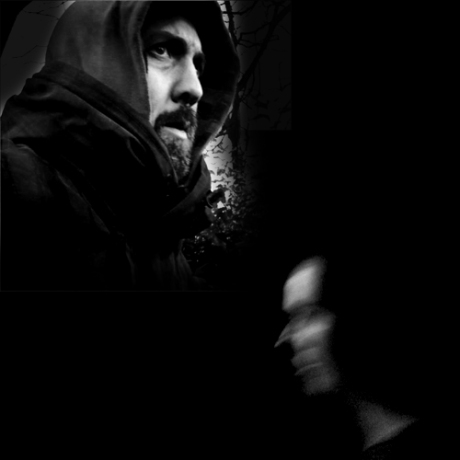
[Jason Kavanagh left, Jay-Dea Lopez right]
Jason Kavanagh website
Jay-Dea Lopez website
Sirona website
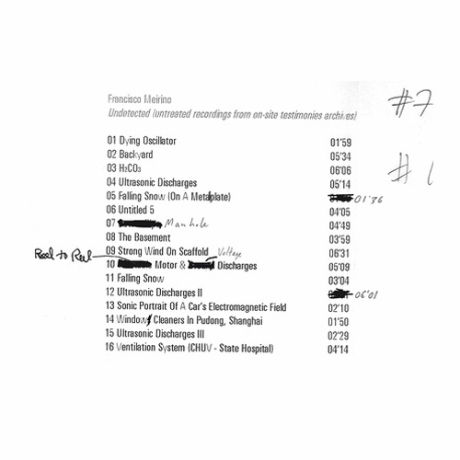
Undetected
(Untreated recordings from on-site testimonies archives)
FRANCISCO MEIRINO
(Oto 2012)
Review by Chris Whitehead
The first release on Takanobu Hoshino’s OtO label, is quite a startling and daring launch. The Fukushima based sound artist has chosen Francisco Meirino to kick start his new venture with an album of stark beauty and purity. It requires a deep listening approach. I know that term is a bit of a cliché these days, but this time I think it is truly valid. This work simply will not reveal the truth at its core without respecting its subtlety.
As soon as ‘Undetected’ arrived through the post I couldn’t wait to hear it, so I slid it into the car CD player to listen to on the half hour drive to work. For a collection as subtle and nuanced as this, trying to appreciate the detail and peripheral disturbances involved proved unfruitful whilst motoring. During one particularly quiet spell I forgot I had I had a CD on at all, there was just the noise of the car’s engine until a sudden thump led me to momentarily think the exhaust had fallen off. It was actually an unidentified loud bang recorded in Meirino’s back yard.
I would suggest that this release requires some preparation before listening. Firstly the environment needs to be pretty silent, preferably dark to avoid visual distractions and obviously the listener needs to be comfortable. Headphones are essential. Ideally Francisco Meirino likes to play live in total darkness, and maybe we should follow his example. Some of the sounds revealed here are on the very cusp of audibility, and yet they are essential to the whole.
‘Undetected’ presents sixteen recordings from Meirino’s archives in an unadulterated form. They appear to be the sort of components from which he often constructs his tracks, but in this instance no composition takes place. Like the parts of an engine laid out on a workbench, Meirino invites us to examine these pure and unadorned sonic objects as they sit there in the cold light of day.
The first track follows a gently fizzing oscillator through its death throes. After two minutes of undulating static the device suddenly blinks out of existence forever with an impressive final burst. This sets the tone for what is to come: The sound of carbonic acid decomposing in water via a hydrophone, crisp and sharp: An unknown recording from a lost archive featuring drum rolls of charged pulses: A manhole on a construction site and strong wind on scaffolding. Sounds that in turn explore open spaces, manmade interiors and microscopic events within circuits and machines.
Three separate pieces are concerned with ultrasonic discharges in voltage circuits captured using electromagnetic field detectors. Like tiny stars punctuating the blackness of empty space, flickers of electricity momentarily flare into existence, only to die away in an instant. This practice reminds me of the Dark Matter search experiments carried out in a 1100 metre deep potash mine close to where I live. The depth of rock cuts out cosmic rays by a factor of 1 million allowing for ultra low background particle detection.
Two variations on the subject of falling snow (one of snow falling on a metal plate and one of it falling onto itself) provide a physical counterpoint to the ultrasonic discharges. Similar in the sense that they record points of sound set against a silent background, continuity is maintained. The sequencing of these selections is important. Listening to the tracks as they occur in order provides the best way into this secret world.
‘Reel to Reel Motor and Voltage Discharges’, gleaned from a tape recorder with belt and high density ground problems, begins with high pitched crackling and a thin sustained buzz before a deep throbbing bass sound underpins everything. Meirino’s fascination with malfunctioning machinery and failing systems seems to bleed into everything he does.
The disc closes with a loud, multichannel examination of a hospital’s ventilation system , rattling machine noise and churning turbines forming a deeply mechanical finale to a superb and hugely rewarding release. ‘Undetected’ delivers more secret pleasures with each exploration of its hidden undercurrents.

[Francisco Meirino photo courtesy of Antifrost]
Francisco Meirino website
Oto website

Interview with D’Incise
by John McEnroe
Over a span of six months D’Incise released ‘The field remains while the recorder has vanished’, ‘Praire’ and ‘Are fishes nihilist?’, works that had for me a very special importance as I found there some sort of vindication of extensive sound processing and detailed montage in sound composition in a moment when contemplative documental releases with very little ‘post-production’ work seems to be more of a pertinent choice.
When I decided to interview D’Incise -to which he kindly agreed- I wanted to approach the interview on a different way so I listened to the releases and wrote a series of words that came to my mind during the process. The idea is that D’Incise in a free-association exercise -in no less than three words and no more than twelve*- writes whatever comes to his mind when he reads each one of them:
Q. Reel
A. Rather that ” musique pour bande” I’d think of ” musique pour haut-parleur”. (I never use tape machines, I’m fully of the digital generation).
Q. Wind
A. Not a sound in itself but one of the more beautiful natural generator of sounds. And the worst situation to record – I love/hate it.
Q. Noisy
A. The “y” makes it, passing from the rough elements of noise to tiny detailed ones, the perhaps shy but elegant declination of any sound.
Q. Movement
A. Why ? Who generate it ? Human ? Nature ? How controled or chaotic ? Go with or against ? Always I wonder what degree of movement I should introduced into my music.
Q. Creaking
A. It’s a well mastered gesture – facinating, just over the silent inactivity, but far under the violence of the beating, a whole area of possibilities when approched with great care.
Q. Insects
A. They have this “micro” aspect, small but still at the limit of what we can yet percieve, as symbolicly as concretley they are a good inspiration for my music.
Q. Deafness
A. Self-deafness? Does someone had done a theary about it ? One is always modifying his earing/perception levels. One can either mute most of the sounds or voluntary push the boundaries of listening… I guess it’s what sound artists try to propose…
Q. Bubbles
A. Small ones are fine but I don’t like big ones.
Q. Crispness
A. Sounds are like bread, it must crisp so you know it’s fresh.
Q. Time
A. Time and atmospheric pressure, it’s all about modulating these two parameters…
Q. Timing
A. Once you get rid of rythmical structure, the strategies for the timing of a music piece become multiple, one can think of natur or physic durations, or human self-perception (ask a few people to count one minute in their heads and you’ll see the huge variation of timing you’ll get). That’s an aspect I’m trying to introspect, I feel one get to easily influenceed by “common” timing, there is more to explore I think, it’s an open field…
Q. Boredom
A. I like that word and idea, in fact it’s so subjective and cultural.. so there is much to play with it.
Q. Anxiety
A. No, no, I’m a positive person, I just don’t like when one makes to much theatre about things.
Q. Textures
A. A texture is a sound without shape. It’s extrating and reaveling one specific aspect of a sound, its “color”. One can do the same process by taking only the shape aspect of mutiple sounds for example, that is a variation of the idea of focusing on reduced parameters of sounds.
Q. Foley
A. It brings me few things in mind;
- I’m so much focused on sounds generaly that I ofthen notice ” unreal” sound situations in films (to not say coarse ones) like helicopter shot in which you could ear not the engine sound but the slight bird wings passing by. And I wonder how poeple can not be shocked by such fake propositions. The force of the spectacle is here, the reality is not questioned, its representation is the reality, point. Scary.
- But even our little community of sound artists I sometime wonder if one do listen to sounds, or ear onyl what the sounds sould be from a commonly admited perspective… (In fact in some of my compositions I used modified recordings that sounded more real, more like something of the nature than the raw ones…)
- However I’m facinate by the process of recording sounds when it operates tricks on the perceptions, when you think you know the source because you rely on some supposeldy acquired references. Thinking about that is to explore what the sounds are made of, and why we perceive them in a certain way.
- (Ah this marvelous scene in Wim Wender’s “Lisbon Story”.)
Q. Glitches
A. I’d say I love them, but also I must admit generaly they are pretty well tamed, pretty well shaped as culturaly accepted.. one should look for new glitches…
(And in the other hand I like the mastered gesture, the precision, the feeling of the right element in the right place, even and perhaps specialy in complex chaotic-like structure.. one often fake disorder to trick the listener at then end.)
Q. Calm
A.Yes, it’s me. (So my music is).
Q. Expectation
A.That’s the big thing, we’re culturaly so build, consequently to play with expectations is a struggle and a reward.. it’s hard, very hard, I’m not sure I succed often, but it seems to me a great field of reflexions and actions…
Q. Machines
A. Not a perticulare facination nor a dogmatic path, but often I found human impulse imprisonned in its reflex, habits, cultural frame, etc., so the uses of other impulses, machines, math, nature, etc., can be some sort of detour to learn more about why we do certain gestures or reactions the way we do. It can allows us to look at ourself from a step aside.
Q. Dis-location
A. I found dangerous, and deeply erroneous, to have absolutes. Yes, let’s dis-locate everything the more we can.
(But also, to separe the location, locations of emission or locations of reception, multiplie the sources and perspectives).
Q. Artificial
A. If you think about the recorded sound as a representation, yes it’s artificial. But if you think about a sound generated by the vibrating cardboard of the loud-speaker, then what you hear is pure reality.
Q. Natural
A. Try to invert what I just wrote…
Q. Surreal
A. Try to mix both sentences and read them simultaneously, perhaps you’ll get some sur-something…
* PS from the D’Incise: ‘I obviously, and conscientiously didn’t respect the three-to-twelve words rule, I guess by reading me you can quite easly notice that I’m not very fond of rules.’
[D'Incise photos courtesy of Ponto Alternativo]
D’Incise website
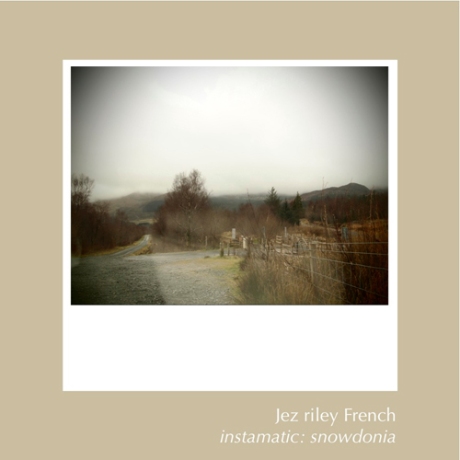
Instamatic: snowdonia. JEZ RILEY FRENCH
(Engraved Glass 2012)
Review by Daniel Crokaert
In his Instamatic series, Jez riley French invites us to share his moments of fortunate listening like they are, without make-up nor intellectualizations, retouches or alterations of the source, except a careful selection and probably a bit of equalization… A hike within some magnificent natural region of North Wales, namely Snowdonia, led Jez to look particularly into the wind, that wind which speaks to us, while sweeping at the same timeendlessly across ever changing landscapes… that air which circulates, lifts, makes particles, objects and surfaces vibrate, suggesting their outlines and concrete features…
But, far more than a report about a physical truth, the work quickly switches over to the extra-ordinary, underlining a very personal way of experiencing, of giving another dimension to things, and our environment… Vast palette of amplified metallic resonances of fences planted in the isolation of a still preserved nature…agitation, vibrations, ferruginous supplications…a whole universe stands out, and submits to the laws of another one…a unhurried play of echoes and reflections coming out of the insignificant, and which reminds us constantly that our perceptions are fluctuating, eminently subjective, and tributary of their “captation tools”, but that they can also be the starting point of unexpected emotions… “There’s an aesthete within us all “ seems to be, roughly speaking, what Jez whispers to us.
Through his care, his methodical record, his sense of listening, the creation of his own range of microphones, Jez acts like a revealer, a non-standard intermediary… “Snowdonia” succeeds in closing our eyes slipping us into a long travelling through shaggy herbs, dishevelled by an insistent breeze – a Malickian scene… Just next to us, trembling & bending wires, streaking the rust tones of a jaded vegetation…pebbles shrouded in history shape long grey veins studding the country as far as the eye can see…in the faraway, the shadow of hills asleep, peaceful guardians of a permanent sight… In our ears, clicks, muffled murmurs of cold metal, aeolian moan, all the tense sensoriality of the world…
“Snowdonia” ends up ringing like the name of a mythical place where one has rendezvous with the other-worldliness…that other-worldliness, disguised under common appearances, here finely caught, and alongside which we often pass by in total indifference…

[Jez Riley French]
-French version-
Dans sa série Instamatic, Jez riley French nous convie à partager ses instants d’écoute privilégiée dans une forme pure, sans fard ni intellectualisation, retouches ou altérations de la source, hormis une soigneuse sélection et sans doute un peu d’équalisation… un trek au sein d’une magnifique région naturelle dans le Nord du Pays de Galles, à savoir Snowdonia, a conduit Jez à se pencher plus particulièrement sur le vent, ce vent qui nous parle, tout en balayant inlassablement des paysages en perpétuelle mutation…cet air qui circule, soulève, fait vibrer particules, objets et surfaces, suggérant leurs contours et caractéristiques matérielles… Mais, bien plus que le compte-rendu d’une vérité physique, l’oeuvre bascule rapidement dans l’extra-ordinaire, soulignant une manière toute personnelle d’éprouver, de donner une autre dimension aux choses, à notre environnement… Vaste palette de résonances métalliques amplifiées de clôtures plantées dans l’isolement d’une nature encore préservée…agitation, vibrations, suppliques ferrugineuses…tout un univers qui se profile et se plis aux lois d’un autre… un jeu patient d’échos et de reflets sortis de l’anodin, et qui nous remémore constamment que nos perceptions sont fluctuantes, éminemment subjectives, et tributaires de leurs “outils de captation”, et qu’elles peuvent aussi être le point d’origine d’émotions inattendues… Il y a un esthète qui sommeille en chacun de nous”, voilà, en gros, ce que Jez nous susurre… Par son application, sa consignation méthodique, son sens de l’écoute, la création d’une gamme propre de micros, Jez agit comme un révélateur, un passeur hors normes…“ “Snowdonia” arrive à clore nos paupières nous glissant dans un long travelling au travers d’herbes hirsutes, décoiffées par une brise insistante – une scène Malickienne… Juste à côté de nous, des fils tremblants et fléchissants, striant les tons rouille d’une végétation fatiguée…des cailloux chargés d’histoire forment de longues veines grises qui constellent les étendues à perte de vue…au loin, l’ombre des collines endormies, gardiens paisibles d’un spectacle permanent… Dans nos oreilles, cliquetis, murmures étouffés de métal froid, plaintes éoliennes, toute la sensorialité tendue du monde…
“Snowdonia” finit par tinter comme le nom d’un endroit mythique où l’on a rendez-vous avec le merveilleux…ce merveilleux déguisé sous des apparences communes, ici, finement capté, et à côté duquel nous passons souvent dans l’indifférence…
Jez Riley French website
Engraved Glass website
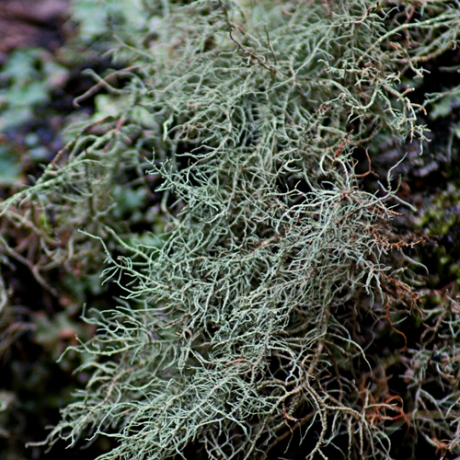
The Field Reporter Radio #12
‘Tiempo inmanente’
by David Velez
Piece composed with recordings captured on August of 2012
Photo: Lina Velandia
.
.
David Velez website

Camino, parte primera. EDU COMELLES
(Wandering Ear 2012)
Review by Jay-Dea Lopez
Perhaps no other pilgrimage route stirs the restless traveller’s spirit more than El Camino de Santiago, the Way of St James. Walking for weeks, sometimes months, pilgrims historically travelled 800 kilometres from the French side of the Pyrenees to Santiago de Compostela in Galicia, a Spanish cathedral that is said to house the remains of the apostle Saint James. In an extremely sensitive release Spanish field recordist Edu Comelles has documented the first stage of this route in “Camino, parte primera”.
Listening to “Camino, parte primera’s” church bells, country streams, Gregorian chants, and robust Spanish conversations it is easy to imagine ourselves into a distant past. It is here that its success lies, the majority of sounds captured by Comelles remaining true to the medieval period in which the pilgrimage began.
Comelles desire to record the sounds along the way may have stemmed from his recent dissertation exploring walking compositions. In it he says the notion of walking is “a simple activity that in the Western Culture and through the years has been widely regarded as an act of discovery and also as an inspiring or meditational act”. By recording the soundmarks along the way Comelles allows us to partake in his discoveries, exposing us to the spirit of the surrounding countryside, its people, and the sincerity in which the walk is taken. In this context “Camino, parte primera” is a refreshing antidote to the cynicism that taints the 21st century.
“Camino, parte primera” follows a linear path, its sequence of recordings corresponding with Comelles’ own trek. Beginning in Roncesvalles we hear bells ringing from an ancient Abbey; a signal that it is closing to the public. Further along we hear feet as they grind along a gravel path whilst the sound of sheep and animal bells ring alongside.
From a cultural perspective one of the most interesting recordings is of the “carraca”, a wooden instrument with 20 hammers that is rattled during the Easter period; the regional law stating that no bells may ring during the Easter period. The religious context in which the carraca is played is cleverly emphasized by the next stage of the track where somber voices are heard singing part of the Easter mass. This recording sounds timeless, its tone resonating long after it finishes.
At times the bucolic ambience presented in Comelles’ recordings may lull us into the false belief that the walk is without any physical challenge, however a few tracks remind the listener of the harsh elements of the pilgrimage. Strong winds are regularly heard buffeting the microphone, the accompanying photos in the release revealing exposed rainy plains that offer little relief from any discomfort.
“Camino, parte primera” finishes with a recording inside the Logroño cathedral. Here an organist is overheard as he rehearses on the cathedral pipe-organ. Wrong notes are struck yet the musician’s perseverance manages to sustain a measure of stateliness throughout the piece. This track is a perfect place in which to end “Camino, parte primera”, Comelles’ notes stating, “tomorrow we take the train back to Valencia”. It is with great anticipation that we await the second part of this release.
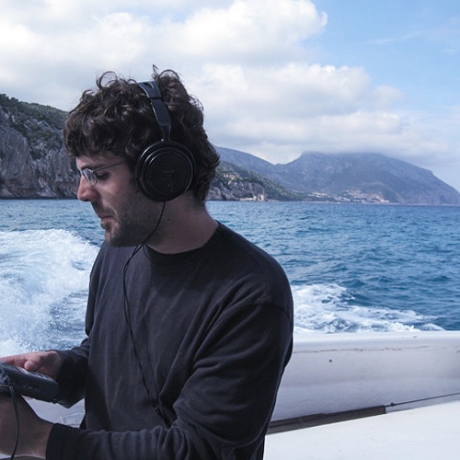
[Edu Comelles photo courtesy of Cazar Truenos]
Edu Comelles website
Wandering Ear website

Lecture on nothing. BRANDON LABELLE
-text by John Cage, lecture by David Kurs-
(Errant Bodies 2011)
Review by John McEnroe
John Cage’s ‘Lecture on nothing’ is a text written between 1949 and 1950 that was first published on 1959 and later included on Cage’s book ‘Silence’. The text is presented with a certain rhythmic structure and should be read with the ‘rubato’ which gives rhythmic speed freedom to the lecturer looking, in this case, for a more ‘every day’ speech form.
On 2009 sound artist and theorist Brandon LaBelle appropriated this text by having a deaf person, in the case of the sound release -theater director and writer- David Kurs, to read ‘Lecture on nothing’. LaBelle took the notion of Cage where silence helps for the listener to be aware of the non-musical and incidental sounds and in general that silence can be a key perceptual element in the listening experience; The way LaBelle articulated Cage’s notion of silence and the ‘nothing’ is very poetic because is only possible to experience silence under deafness conditions. John Cage visited an anechoic chamber on a quest for silence and noticed the sounds of his blood and nervous system while he was expecting to hear ‘nothing’.
The experience when listening LaBelle’s ‘Lecture on nothing’ is complex and not an easy one. The obvious difficulties in Kern speech have a strong emotional effect at least on me as a listener and have to accept even touches what I could call some moral and ethical aspects of my persona which I guess totally misleads my reviewing process. Likewise the fact that Kurs, a person whose work implies sensibility, creativity and artistic sense, is the one reading the text gives to the project complete ethical insurance.
‘Short circuit’ by Brandon LaBelle from the early 2000′s was a very important text for me as it deals with a subject of great interest: the presence of sound art manifestations in the gallery / museum context. When I received ‘Lecture on nothing’ I really treasured it not only as a beautiful edition but also as an object. ‘Lecture on nothing’, unlike most releases we usually listen, does offer little ‘entertainment’ and instead puts the listener outside his comfort zone which is a situation that is more often found in an art exhibition that in the couch in our house with the lights off listening on a hi-end audio stereo system with a glass of single malt whiskey in our hands.
This sense of unease and discomfort is very important here as it is what helps triggering questions and reflections that hardly could arise on a comfortable entertaining situation. The concept behind the release is backed up with a very strong formal display that simultaneoulsy affects the listener intellectually and sensibly.
David Kurs doesn’t listen, he experiences silence. He might sense sound in a tactile way but he can’t listen. Now I wonder, bringing back Cage, how David Kurs’ experience with ‘real, silence draws him to somehow relate to the actual listening process. For David Kurs sound is an impossible as silence it is for us, it is something that occurs outside him, outside his senses; a notion, something he can only imagine. In the other hand when we use noise canceling devices, which provides something close to silence, our listening turns to the sound produced by own body as it happened with Cage’s experience on the anechoic chamber. Silence then appears as a metaphorical figure of listening to ourselves: a sort of internal path, a direction, a vector, which totally differs to a more common notion of silence as a state or condition.
LaBelle’s ‘Lecture on nothing’ is a ver powerful catalyst of ideas, reflections and questions about silence, about this thing that only occurs in our imagination; about how this ideal figure somehow connects with our sensible experience and in the end how silence can work as some sort of link to a universe beyond our senses as it happens to David Kurs with listening when he is reading Cage’s text.
Hardy can picture a better way to celebrate Cage’s centenary than by accessing ‘Lecture on nothing’ as it digs deep into our notions of listening and experiencing things in general.

[Brandon LaBelle photo courtesy of Migrating Art Academies]
Brandon LaBelle website
Errant Bodies website
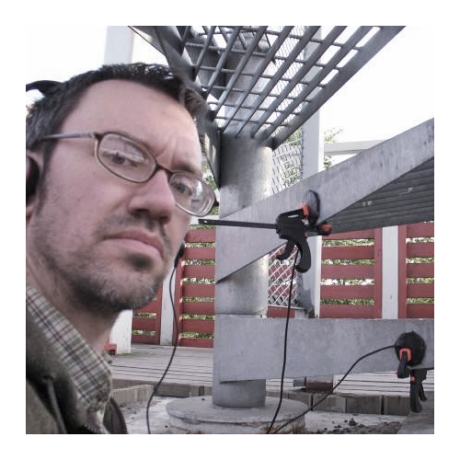
Interview with John Grzinich
by John McEnroe
When I get asked about the most successful and interesting sound art releases of 2012 one that will come to my mind is ”Madal öö’ by John Grzinich. When I knew from the artist that it almost went unpublished I felt intrigued to know more about it, so I made him a few questions that he kindly offered to answer for The Field Reporter.
Q. On ‘Madal öö’ you compiled recordings made during a two-year span that you captured on the twilight time. I wonder what kind of relation or connection was established between all this many individual moments on the put-together process of ‘Madal öö’?
A. I’m not sure I understand the question but the simple answer is, I basically had to think about my relation to the places, the recordings and the potential audience of listeners. But this goes with any type of recording, no?. In this case the ‘production ethic’ was minimal, to limit my involvement in the process and present the recordings as they were made. In general I do construct a strong conceptual frame for my compositions, films, installations etc., but for ‘Madal öö’ it was even hard to want to title the CD. Each track is listed as the time and place of the recording and actually that’s enough. I trust the listeners’ ears and minds to fill in the rest.
Q. Regardless of the level of edition or non-edition (assuming there was not significant processing of the captures) ‘Madal öö’ sounds particularly real and vivid which allows for a potential strong connection between the listener experience with the release and your own experience with the environment during the recordings. Aside for the equipment and all the technical aspects, what would you say is the key for the strong realism on the ‘Madal öö’ sonorities?
A. That’s an interesting question and one that is not easy to answer. Since I was present at the time of the recordings and have a strong connection to many of the locations, its hard for me to hear these recordings from a fresh perspective. Many people have noted the “realism” of the recordings which is pleasing to hear as I sincerely wish to communicate as much as possible about the rich sonority of these environments at this particular time of year. If there is anything that connects these recordings, it is the phenomena that the title implies, what I’ve called “shallow night”. During the eternal twilight of the spring evenings, the air can become extremely still. This means that all of the sounds and movements of creatures can be heard clearly, making their distinct points in space very present. As we know, wind essentially adds noise to an environment, so I think of these recorded moments of stillness as being very high fidelity (to borrow Schafer’s terminology).
Q. What was the purpose behind you going out very early in the morning for some days during two years to record in Pölva? Was that part of a process or rather a habit?
A. As an active recordist I do have a habit of going out regularly especially during spring time. Its probably a combination of the long winters and the magic of the white night that makes me just want to be outside. As I mentioned this time of day also tends to be very free of wind and human generated noise. Along with my colleague Daniel Allen, I also got inspired by the Nature Sound Recording workshop we hosted at MoKS in 2011, where fellow recordist and biologist Veljo Runnel opened the window to identifying many of the bird species in the region.
Q. Pölva is not only the subject of ‘Madal öö’ but also the region where you live. What can you say about the connection and differences between recording home and recording away not only in the capturing process but also on the montage process?
A. Well, it can be difficult to keep up inspiration on home territory because when you travel abroad everything seems exotic. Many people think you have to go to the arctic or a tropical rainforest to make interesting recordings. But I’ve always tried to explore everyday familiar territories in a way that makes them more magical in a way, specifically to really ‘listen in’ and focus on details as well as ‘zoom out’ and understand the diversity that really exists and how it changes throughout the day, month or year. When I compiled the tracks for the release I thought about how to share these perspectives and to frame specific moments that were captured in a way that made my position more transparent.
Q. On ‘Madal öö’ we can hear mostly sounds from the ‘nature’ such as toads and birds. We also can hear the sounds of dripping, splashing and running water. Anyway we can also hear sounds that are either: very musical, hardly to identify or sounds of what seems like human activity that somehow ‘interrupt’ the more natural sounds. Do you have anything to say about that?
A. What you describe is really the conditions that exists in most environments, its just that we often tune out certain elements or get overwhelmed when a place becomes too noisy. I’m not really a purist when it comes to recording environments. I like recordings with a deep spatial “image” and if that happens to include a diverse array of sounds, familiar or not, natural or mechanical, it doesn’t really matter. Of course what I like about these areas is that they are protected yet accessible. In general, Estonians like to get out in ‘nature’ which helps to develop their respect for it. On the other hand, while it looks like a very rural area, there always seems to be a farm or village around the corner. I often hear things that the microphones captured that I didn’t hear with my ear.
Q. In relation to the previous question, on the review I wrote for ‘Madal öö’ I spoke about the documental, political and poetical importance of phonography in terms of capturing the sounds of environments that are quickly changing because of the sound pollution as the principal factor. Is the sound pollution a subject that concerns you? And if it does, how this concern relates with your work as sound artist?
A. I’m of course concerned with issues of sound pollution, not only in regard to how it shapes our environments, but also in the way it shapes us as listeners. From my experience in teaching and doing sound workshops, it takes great effort to get people to focus on sound and listening. You can take the average person and place them in a quiet environment, but it doesn’t mean they will hear it. There is a common story from many people who practice field recording, where they will be asked by a stranger about what they are doing. The recordist responds by describing the sound and the stranger has no idea what he or she is referring to. Noisy environments tend to decrease our sensitivity to individual sounds. Although strangely enough, I found that particpants in my workshop in Istanbul which can be a very noise city, were able to be highly focused on sound and listening, so its also a cultural attitude, not just individual.
Q. Why you said that ‘Madal öö’ almost went unpublished? Was it purposed to work on another media (sound installation, broadcast…)? Why it finally became a sound release?
A. I simply didn’t have plans to use this material before. Its hard to know what to do with straight field recordings. There’s so much material already out there, also with nature sound recordings, I certainly don’t feel its necessary to publish everything. In fact my published output is very small in comparison to the archive of material I generate. But, it wasn’t until I put a few excerpts up on soundcloud that Jez Riley French noticed and encouraged me to compile the material for a release. Jez has been to Estonia in our residency and even knows a few of the locations so he probably wants to help share the beauty that exists here and I thank him for that. And judging by the positive response to this release I will definitely consider releasing more straight field recordings.
Q. Finally how you see ‘Madal öö’ as part of your ongoing artistic process and what importance does it have after the many years you have publishing works on the sound release format?
A. I actually don’t consider this as much of an artistic statement as my other works (although I understand there is an artistry in making good recordings). In many ways I tried to be more or less invisible as an artist, in assembling these recordings. Much of my compositional work is processed and layered, but with ‘Madal öö’ I didn’t do anything apart from select parts of the recordings and adjust some levels. In the end I think Jez even proposed the track order and did the design. Nevertheless that an ongoing but good debate concerning ‘field recording’ which has become sort of a genre apart from a specific type of recording method.
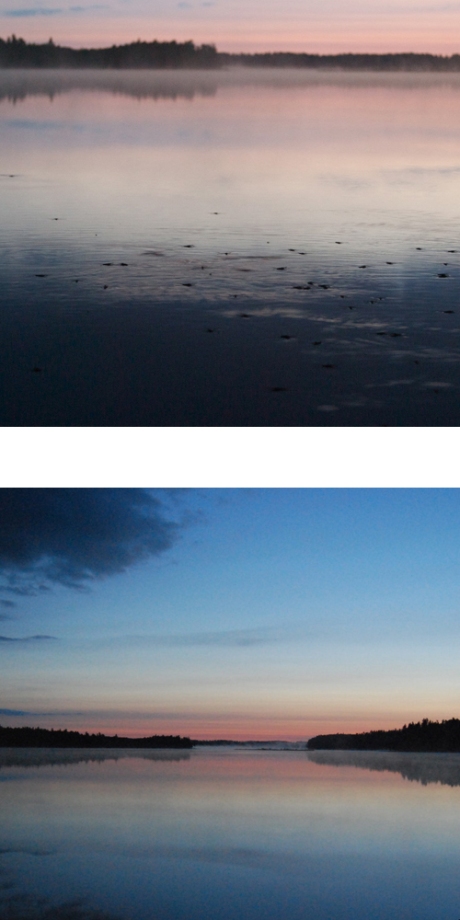
[Pölva location photos, author John Grzinich]
* [John Grzinich photo courtesy of the artist website]
John Grzinich website
Review of Madal Öö on The Field Reporter by John McEnroe

Are fishes nihilist? (all this is not realistic)
D’INCISE
(Kaon 2012)
Review by John McEnroe
There is an interesting text written by D’Incise Feraille on the booklet where he talks about the difficulties he faced while working with Cédric Peyronnet’s recordings of the Taurion river. He writes that he needed to create a certain distance between him and the subject, the river, to finally give form to the project.
D’Incise work is closer to the electroacoustic line of work and this probably helped making this project particularly interesting as most of the previous ‘river’ series on Kaon were rather phonographic or concrete.
The question ‘are fishes nihilist?’ brings to the table loads of aspects that has been largely discussed within the sound art context in regard on the universal and specific sense. On existential nihilism the universal sense can be so large and overwhelming that the parts that compose this universe could seem insignificant and without any transcendence.
In regard of this release I’d like to ask a question: What is the river? My speculative answer to that is that river is all that makes a river a river without the river.
The ‘river’ is just some sort of image or notion on the artist’s perception that he formally develops within the relation he establishes between his sensible experience and his duties as crafter of sound compositions.
The distance that that the artist created with the subject was there when the project first started whether on Cédric Peyronnet or on D’Incise Feraille’s side. This because the artist seems to be more interested on the formal aspect of things than on the ‘things’ themselves.
On ‘Are fishes nihilist?’ the river is there: the listener can hear the textures, the movement, the flow, the change, he can hear what makes a river a river without the river which at the end is one of the ultimate stances of the artistic creation. This alone makes this release highly effective and successful. Now add to that the rewarding emotional experience that the listener can found through the 23 minutes the piece lasts. The composition work here in its formal value is highly compelling as all the aspects were properly taken care of: timing, shaping, texturing…everything works here as all matters were dealt with very unique and strong sensibility, imagination and emotionality.
This release adds to an accomplished year of very rewarding works by D’Incise Feraille, all of them presenting a very particular sense and direction, and most of them pertinently reviewed by this journal.

[D'Incise, photo courtesy of Last FM]
D’Incise website
Kaon website

Two films. JOHN GRZINICH
(And/oar 2012)
Review by Jay-Dea Lopez
Electrical power-lines humming above open farmlands, lifeless branches hitting ice-coated wires, waves echoing as they lap inside pipes; these are only a few of the sounds captured by John Grzinich in “Two Films”. This mesmerising DVD, released by the and/OARlabel, unveils the sonic life that envelops us, unheard without the aid of microphones or the inclination to listen. Born in New York, and currently living in Estonia, Grzinich has been working with sound composition since the early 1990s. Only more recently has heseriously focused on film as a creative medium.
It is the bleak landscape of Estonia that features in “Sound Aspects of Material Elements”, the first of the two films. In grainy black and white footage the audience is privy to long static shots of abandoned spaces and beautiful wastelands. As we observe the frozen Estonian countryside’s lop-sided power-lines and decaying farm structures it is easy to imagine a localized apocalypse occurred here decades before. All visual cues in the film suggest a blanket of silence pervades the area, however it is through Grzinich’s well-trained ear and microphone work that this assumption is shown to be false.Electricity continues to flow through the power-lines, its lethal charge being heard in low oscillating drones; water drips from the ceiling of an abandoned cement building, falling into pools whose varying depths create a polyphonic melody; a dormant tree branch sways in the breeze, delicately striking a wire at irregular intervals.
The sounds that Grzinich captures are mesmerising, each are featured for less than four minutes at a time. The recordings seamlessly fade in and out to create a single composition. “Sound Aspects of Material Elements” also shows that Grzinich is not content to compose solely through the use of found sound. In several shots we see Grzinich interacting with objects in the environment. Pieces of detritus become objects to strike, scratch and record. A huge metal tank echoes as three men scrape its side; an old tower creaks and groans as Grzinich climbs its damaged rungs; in a beautiful scene a metal surface amplifies the sound of tuning forks as they are slowly placed upon it.
In other recordings Grzinich uses creative techniques to present new ways of listening to familiar objects. Microphones are inserted into bottles and then placed next to open fires, the pop and crackle of burning wood echoes inside their fragile glass chambers; waves and dried grass are heard through the distorting effect of long tubes; a wire is stretched across a stream, its reverberating tone shifting under the bubbling flow of water. Explaining his approach Grzinich says “All the sounds captured formed the basis for each shot emphasizing how the combinations of certain materials (metal, wood, glass) along with natural elements (water, wind, fire), transforms our perception of even the most common everyday places or situations”. After watching this we listen again to these primeval elements with a renewed vigour.
“Mimema”, the second of the two films, is described by Grzinich as “the soundtrack for the half submerged floaters drifting at dusk on the still lakes”. An organ softly holds long wavering notes alongside recurring images of foliage, cobwebs, foggy countryside, and a face calmly immersed in water. Visually “Mimema’s” pace of editing sometimes runs ahead of the composition, nonetheless an emotional impression resonates long after the film reaches its end.
“Two Films” is a profound work of art, throughout its duration we are spellbound. As the films unfold we sit mesmerized by the soundsand images emanating from the screen. It is a pleasure to watch Grzinich in the field, the visual connection with the sounding objects providing a greater appreciation for his work. After viewing “Two Films” it is hard not to imagine the sonic potentials that lie around us, untapped, waiting for a microphone to be directed towards them.
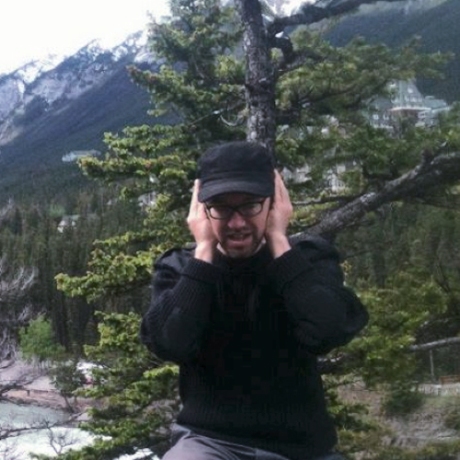
[John Grzinich]
John Grzinich website
And/oar website
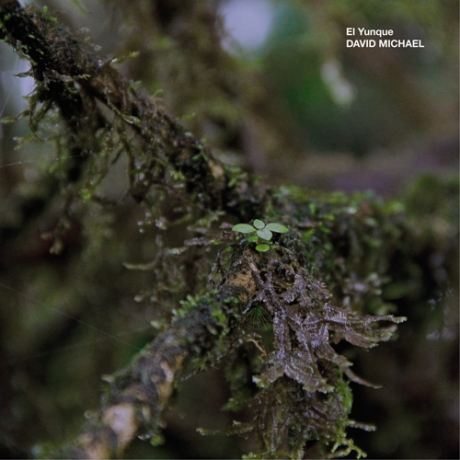
El Yunque DAVID MICHAEL
(Impulsive Habitat 2012)
Review by Cheryl Tipp
We all have our own preconceived notions of what a rainforest should sound like, even if we’ve never actually visited one. Film, television, audio publications and images all contribute to the formation of these sonic identities in our mind. Preconception is at the heart of ‘El Yunque’, a wonderful new release from field recordist David Michael. For over two hours we are treated to an uninterrupted recording of Puerto Rico’s El Yunque National Forest after dark. The content is fairly simple – insects and frogs dominate the soundscape throughout – but this in no way lessens the quality or appeal of the piece. In fact, I think the steady temperament of the recording, together with the subtle variations in sound as we move through the night into daybreak, create a rich and soothing atmosphere that is a real pleasure to experience.
In the accompanying notes to ‘El Yunque’, Michael speaks about his personal preconceptions when approaching this recording project. He also mentions his initial disappointment with the final recording, referring to it as a “total travesty”. The recording he came away with was unexpected because it didn’t represent the sounds of “his” rainforest. As listeners we also draw on other sources and our own formulised ideas of how something should sound. For me, the 2012 Gruenrekorder release ‘Sempervirent’ by Rodolphe Alexis is an example of approaching field recordings with a predetermined idea of what to expect. Having heard other publications that focused on Costa Rican rainforests, I expected to hear the same kind of atmosphere. In fact, I was surprised. ‘Sempervirent’, as with El Yunque’, presented another, perhaps more realistic, take on what a rainforest actually sounds like, thereby encouraging us to re-evaluative the way we, as listeners, approach a supposedly familiar subject.
The length of ‘El Yunque’ is not really conducive to prolonged, concentrated listening, but that is not an issue because the publication works so well as a background piece. There is enough detail to keep your ear interested, but not too much so that you become distracted from whatever you happen to be doing at the time (cataloguing African bird recordings in my case). Michael has mastered this kind of sustained listening experience – as with his beautiful track ‘Midnight with a Visitor and Coyote’ (Frick Pond, Fieldcraft Records 2011), he successfully manages to avoid any monotony through careful yet seemingly minimal editing.
The foreground is the dominant element of ‘El Yunque’ but pay attention to the background and other middle-distance elements that occasionally drift into view. Barking dogs, crowing roosters and forest birds that come and go through the night are accompanied by the distant sounds of passing cars and faint cheering from a nearby boxing match. Even the gentle snores of our field recordist don’t escape the microphone!
‘El Yunque’ is another great success for both David Michael and the brilliant netlabel Impulsive Habitat’, who consistently produce free releases of the very highest calibre. It’s encouraging and inspiring to see some of the finest names in this field dedicate their efforts to producing phonographic works that are freely available to anyone who wants to listen. This latest addition is just another good reason to lose yourself in the Impulsive Habitat catalogue.
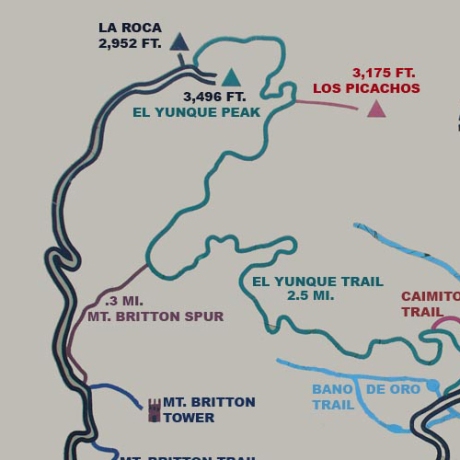
[Map of El Yunque]
David Michael website
Impulsive Habitat website

Ultrealith.
ATRIFICIAL MEMORY TRACE -Slavek Kwi-
(Gruenrekorder 2012)
Review by Chris Whitehead
Let’s deconstruct a rainforest and rebuild it as a sound object. Let’s walk into it, experience it and find a point where fragments of the modern world bleed in.
A bell-like tone repeats and tethers ‘Meadow’, the first track of Slavek Kwi’s ‘Ultrealith’ CD, firmly to the substrata of field-recording based composition. Gentle flutters or sudden bursts of unidentified noise invade the space, but natural sounds also drift in and remain in the background in various configurations, often before vanishing back forever into the ether. Disarmingly, a woman suddenly asks ‘what do you think?’ seemingly from part of a phantom broadcast that disappears as soon as it is detected.
As always with Kwi the feeling that pervades his compositions is a sense of awe at the diversity of nature. Images of rainforest creatures, insects, bats and frogs decorate the book of photographs that comes with ‘Ultrealith’, and even in the tracks that don’t explicitly harness the rainforest as a source, we still get the feeling that teeming life is all around us.
‘Expirations’ is based on the sounds of insects, and they fly around our ears like airborne motors. The correlation between these creatures and tiny machines is an easy one to make with their hard, evenly contoured exoskeletons, jointed legs and otherworldly eyes. The rapidity of their wing movements and their stridulations are a common motif in this piece, but a host of other sounds are woven into the picture. Birds, water, bangs, cracks, fizzes, whizzes and pops. Bullets! Smashed glass! It joyfully ends with a small frog’s single croak.
The next 44 minutes belong to a totality called ‘Subaquantum Ultrealith’. It is broken down into five very different tracks, and as far as I can see, the only glue binding them together is the fact that they were all part of a 4 channel performance project made in 2009.
Three of the tracks once again draw from Kwi’s nature recordings, and his control of the medium is astonishing. They are threaded through with well positioned incongruity though, just in case we lapse into thinking that these are soundscapes existing out there in reality. Oddly, during ‘Insectin’ a voice asks ‘and how does that make you feel?’ a few times in gradually diminishing repetition. How does it make you feel? Well it makes you feel like listening to it again to make sure you heard it right the first time.
The two remaining tracks that form ‘Subaquantum Ultrealith’ are conspicuously different in their formal design. ‘Monochrome 1’ is dedicated to John Cage and consists of 64 recordings of the same voice piled upon each other. It is like listening to sensory overload made audible and is reminiscent of Kraftwerk’s ‘The News’ from ‘Radio Activity’. If listened to carefully, as when in a room of chattering people, directing attention to a single voice can yield meaning.
‘Monochrome 2’ is another construct of predominantly human activity. 60 tracks of a man improvising on a guitar coalesce one by one until he is in his own orchestra of clones. A table tennis game is taking place early on. Recordings of crowded places, perhaps a cafe or a tube station. Then frogs. Frogs. Then nothing.
Finally ‘Pet Radio’ is a section utilising the sounds of domestic pets, which in a way also celebrates the act of bringing the wildness of nature into our homes. Cats, for instance, are still hunters and killers, however much they curl up in front of the fire purring and mewing. Eerily domestic birds such as canaries and parrots are heard surrounded by silence, implicitly suggesting their removal from their environment. Sleeping cats sound forbidding and machine like, not too many degrees of separation from the growl of a lion. When playing ‘Ultrealith’ at home our two cats came in during the bird squawks, pricked up their ears and stared at the speakers. Clearly the residual memory built into their DNA of stealthy predation is not so far beneath the surface.
Beautiful in its construction and realisation, yet not afraid to bowl the odd googly, as we say in England, ‘Ultrealith’ is a work of intricate composition that no one but Slavek Kwi could conceivably have produced.
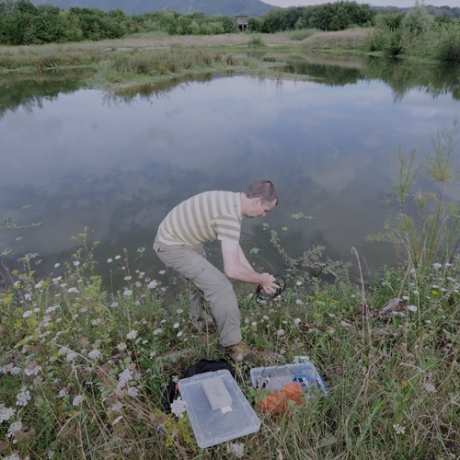
[Slavek Kwi, courtesy of Arteleku]
Slavek Kwi website
Gruenrekorder website
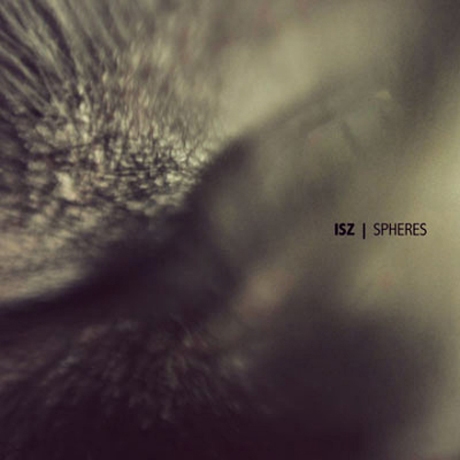
Spheres. ISZ -Miguel Isaza-
(Audiotalaia 2012)
Review by John McEnroe
Miguel Isaza is a sound artist from Medellin, Colombia and ISZ is a ‘electroacustic’ project where he captures sounds and processes them to generate a ‘new reality’. I have been following this project from some time now and could say that in ‘Spheres’ he managed to accomplish some of his best results in terms of re-creating this sense of reality.
Although it’s clear that we are in front of a work that ranges from electroacoustic to concrete, the materiality and spatiality of ‘Spheres’ is somehow believable even though certain sonorities remind us that we are in front of this ‘other’ reality where the electronic and digital means seems to be a structural part of how things are built.
A fact that I find relevant here is that Miguel Isaza is very interested in sound design for films and mentions Walter Murch’s work as a subject of particular interest. I mention this because the works he publishes under his ISZ project, and ‘Spheres’ in particular, have a strong cinematographic character where a narrative is built through a series of events that the listener could link on the timeline and that build a very strong emotional content as the piece develops. This sense of narrative is built under a micro-macro approach: motion and change are there expressed though a very effective use of natural and generated reverberations, textures and objects and the formal development of this aspects set up a very effective universal character, where there is a sense of wholeness and a sense of detail.
On “Spheres’ when wholeness and detail interact they manage to tell a story where emotions leads to images rather than the other way around: images of resonances, volumes, spatialities and sufraces that the listener could perceptually build through a very meaningful experience. For the people interested on the more concrete and electroacoustic ends of field recordings based composition ‘Spheres’ is a very rewarding listen.
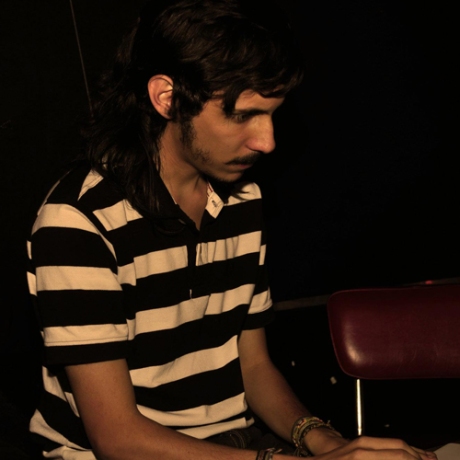
[Miguel Isaza, photo courtesy of Fundación Cuatro-Dieciocho]
Miguel Isaza website
Audiotalaia website
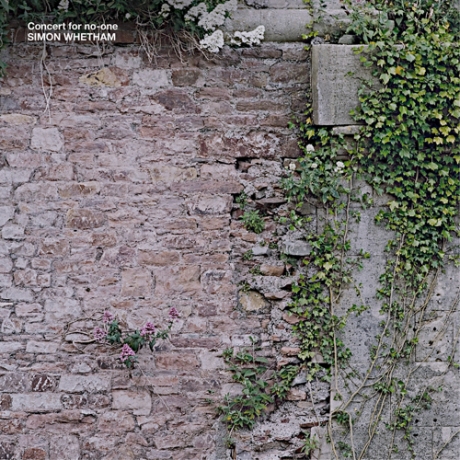
Concert for no-one. SIMON WHETHAM
(Impulsive Habitat 2012)
Review by Flavien Gillié
Capturer l’essence d’un lieu, le faire résonner sans pour autant s’effacer, faire de son corps en mouvement une partie prenante de la performance, aussi petit soit-on face à une cathédrale indifférente, promise au sort commun à de nombreux bâtiments, une forme trompeuse où l’on remodèle l’intérieur, détruisant tout l’espace, n’en gardant que les murs de façade.
L’artiste nous donne à écouter trois prises de sons superposées, d’où se dégage une immédiate sensation de proche et de lointain en simultané, les microphones ayant été placés dans différentes parties de la cathédrale.
Il y a quelque chose de l’ordre de l’isolement, c’est une oeuvre empreinte de solitude, mais avant tout c’est aussi une oeuvre engagée, comme un témoignage retrouvé du dernier résident, une trace d’avant la fin.
Oh bien sûr il n’est pas aussi seul qu’il l’écrit, on entend quelques pigeons, oiseaux de falaises ayant trouvé leur nid dans ce lieu abandonné. Il s’entoure par ailleurs d’une guitare et d’un e-bow, crée un onde stationnaire qui vient nimber l’espace. Il précise par ailleurs qu’il avait prévu d’enregistrer la harpiste Rebecca Sharp, des changements de calendrier l’ont contraint à venir seul, et c’est peut-être mieux. Loin de nous l’idée de dénigrer les qualités de son amie musicienne, mais certains lieux, nécessitent qu’on s’y rende dans la plus grande solitude, et ici c’en est un.
A bien prêter l’oreille on entend peu avant la fin une ambulance qui passe au loin, ça n’a rien d’anodin car autour le silence était presque total, hormis une corde en vibration sous l’e-bow, qui n’est pas sans rappeler le son d’un électrocardiogramme plat, quand le coeur de la cathédrale a cessé de battre, mourant seule, l’ambulance est passée, véhicule trop petit pour un si grand malade.
Seuls les pigeons subsistent au final, quand s’éteint la dernière pulsation vitale, quand on a rangé les chaises, quand il ne reste plus personne, sauf bien sûr les agents de l’immobilier.
L’artiste devient alors un prêtre isolé, et ce n’est pas tant un concert pour personne qu’une messe funèbre pour personne qu’il nous propose, une dernière cérémonie pour des ouailles disparues, à la mémoire d’un lieu de culte qui sera reconverti en espace de bureau, une religion chasse l’autre, pas forcément pour un mieux.
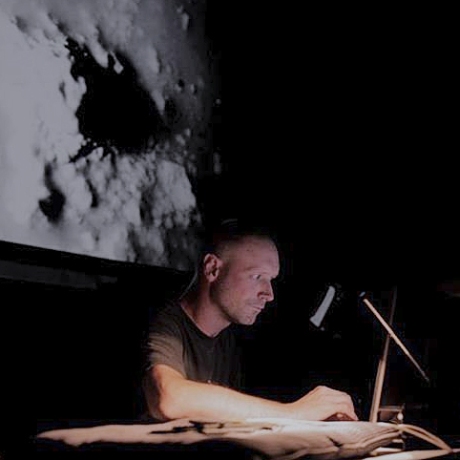
[Simon Whetham]
Translation to English
Translation by Sismophone
Capturing the essence of a place, making it resonate without fading, using his own moving body as an intrinsic part of the performance, as small as one can be in front of such a careless cathedral, doomed to the common end of numerous buildings, misleading shape whose interior is remodeled, destroying all space, keeping only the front walls.
The artist offers three superimposed sound recordings, out of which emanates an immediate feeling of closeness and remoteness together, as microphones were placed in different locations in the cathedral.
There is something about isolation, it is a work marked with loneliness, but above all, it is a committed work, as a retrieved testimony from the last inhabitant, a trace from before the end.
Oh surely, he is not as alone as he claims to be, one hears some pigeons, cliff birds having built their nest in this abandoned spot. He also gains company, a guitar and an e-bow, creating a stationary wave that haloes space. Besides, he states that he had planned to record the harpist Rebecca Sharp, calendar issues forcing him to come alone, and that is probably better. Not the point to diminish the musical qualities of his friend, but certain locations appeal for an utter solitude, as this cathedral is.
Closely listening, one grabs almost at the end the distant siren of an ambulance, and this is just not trivial, as around silence was really total, unless the vibrating string below the e-bow, which recalls the pitch of a flat electrocardiogram, when the heart of the cathedral gave up beating, dying alone, ambulance has gone, too tiny vehicle for a so huge patient.
Only pigeons remain at the end, when disappears the last vital heartbeat, when chairs are tidied up, when there is no one left but the real estate agents, of course.
The artist becomes a remote priest, and what he proposes is not so much a concert for no one than a requiem mass, some last ceremony for a lost flock, in memoriam of a worship place soon to be converted into business spaces, one religion chases another away, not always for the better.
Simon Whetham website
Impuslive Habitat website

Rio Douro / Douro River, Vol 2. VIRGILIO OLIVEIRA
(Green Field 2012)
Review by Cheryl Tipp
Earlier in the year I reviewed Virgilio Oliveira’s first compilation of field recordings made along the Rio Douro. This collection of 13 recordings took in the sounds of the river itself as well as the surrounding environs to create a sonic overview of his journey alongside this Portuguese waterway.
A different approach has been taken with Rio Douro Vol 2. Recordings have been gently mixed to create a flowing composition that gradually shifts from one sound source to the next. Again, variation is at the heart of this publication. The Rio Douro is not always sonically apparent, yet all recordings, whether environmental or not, are linked in some way to the river. Water does of course play its part, but these sections are counterbalanced with others that feature subjects such as singing, music, snippets of conversation and much more.
The pace of this second volume seems that much slower than its predecessor; this probably reflects the fact that recordings were made during the winter months of 2012. Life alongside the river seems to be in a state of semi-dormancy; things are still happening but at a much slower tempo than was encountered during the previous recording expedition over the summer of 2010. When comparing the two publications, the lack of wildlife in volume 2 is starkly evident. With volume 1, insects and birds create a continual thread that runs throughout the compilation, yet their absence is keenly felt here. This void reinforces a feeling of latency, of a torpid environment patiently waiting for its revival at the first signs of spring.
At just under 20 minutes in length, Rio Douro Vol 2 comes to a close far too quickly. I for one could easily have listened to more. This is not a criticism though. In many ways, this composition is perfect the way it is; the piece is just long enough to facilitate a good number of varied field recordings yet never becomes boring or repetitive. Thus, being left wanting more can only be taken as a compliment and reflects Oliveira’s competence as both a field recordist and an artist.
With two volumes of related field recordings under his belt, I wonder whether we will see further compilations or compositions from Oliveira that have their roots in the Rio Douro. I really hope we do as these two forays into the many soundscapes of this river have definitely left me hooked.

[Virgilio Oliveira]
Virgilio Oliveira website
Green Field website
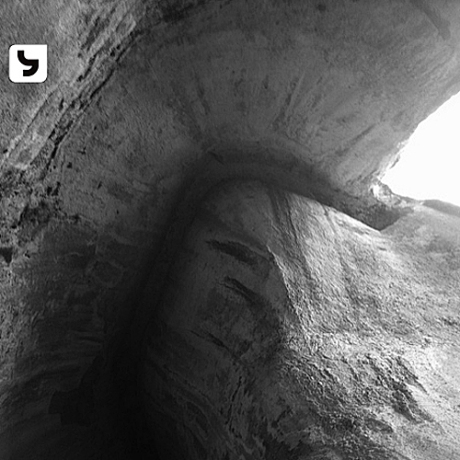
Sceneries from the Castellated Wall. YASUHIRO MORINAGA
(Galverna 2012)
Using words to describe sound can often be anathema to the emotional experience of listening, our reactions to sound existing beyond the mental processes used by our everyday lexicon. This fact is clear when listening to “Sceneries from the Castellated Wall”, a sonic tribute to imagined landscapes and time by Japanese sound designer Yasuhiro Morinaga. Implementing field recordings from the streets of Ireland and Sicily’s Ear of Dionysius Morinaga effectively uses sound to build territories both real and mythological, from the past and present, in what could be considered one of the most intriguing releases of 2012.
“For La Donnaccia”, the first of three tracks, is Morinaga’s homage to a little known film of the same name by Silvio Siano. The film, set in a village suspended in air, is ripe for sonic exploration. A faint ethereal drone is juxtaposed with the quiet rural sounds of cowbells, birds, sheep and cattle, allowing the listener’s imagination to run free. Morinaga’s village is as serene as the air in which it floats, an Arcadian scene that is difficult to leave behind. The deceptively simple use of field recordings in this track illustrate the power of sound in creating imaginative landscapes in which we might all wish to reside. To Morinaga’s credit his composition complements Siano’s film without foregoing his own aesthetic.
“Parade”, the second and longest track, moves to a more concrete world. By modifying field recordings taken in Londonderry Morinaga constructs an imagined landscape from the sounds of this real city. Smooth waves of processed sounds create an atmosphere reminiscent of a city late at night, the streets desolate and thick with fog. As the track nears its end recordings of birds and a female voice briefly appear, bringing a more ambient edge to the soundscape. This section serves as a bridge to the more electronic beats which bring the track to a close.
The final track, “Ear of Dionysius”, uses various techniques of sound design to present a moment Morinaga experienced within this natural acoustic chamber. The Ear of Dionysius, a limestone cave on the island of Sicily, is shaped in the form of a human ear. The acoustics in its space are said to be so acute that political dissidents were held there under the reign of Dionysius I (432-367 BC) in order to monitor their whispered conspiracies. The acoustics were also said to carry the screams of the tortured prisoners throughout the cave. Enveloped in these ancient stories Morinaga’s choice of subject neatly fits within his exploration of real and mythological spaces, bringing “Sceneries from a Castellated Wall” to a perfect end.
There is something romantic and whimsical about “Sceneries from the Castellated Wall”, yet the mastery of Morinaga’s work is completely solid. At no point does the tension of each composition waver. Morinaga’s background in film has honed his skills in projecting images through sound, an admirable feat and one that has set a precedent to future sound designers. “Sceneries from the Castellated Wall” is the second official release from the new Galaverna catalogue, a valuable addition to the world of field recording and sound design.
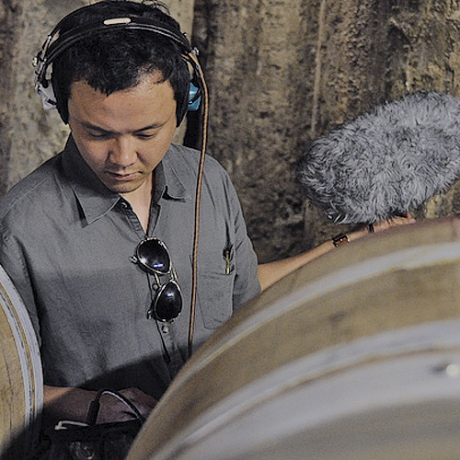
[Yasuhiro Morinaga, photo author Leandro Pisano -all rights reserved-]
-Jay Dea Lopez
Yasuhiro Morinaga website
Galaverna website
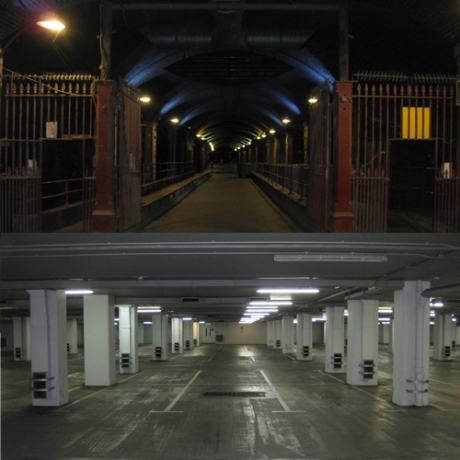
The Darkness and the light. SETH COOKE
(Compost and Height 2012)
For ‘The darkness and the light’ British artist Seth Cooke captured recordings on Leed’s underground parkin lot ‘The Light’, and on ‘Dark Arches’ a stretch of brick-walled tunnels beneath Leeds train station. It’s possible, after reading the liner notes and listening to the piece, that for ‘The Light’ he played a sinusoidal wave in site that will appear on the recordings as part of the environment. On ‘Dark Arches’ he recorded the tunnel while it rained on a Monday morning.
An interesting fact is that, due the hour and wheather circumstances, no cars moving where recorded on the parking lot and no trains moving where recorded on the train station. This fact probably gave to the work a complete different outcome and again, sometimes being left to the derive and the surprise is a big poetic part in the artistic documental process.
‘The light’ is a strong piece in terms of the tensions that arise through the 31 minutes. The idea of making the ‘montage’ on site on real time by playing a sinusoidal wave on location pays off as a rare and beautiful sense of environment is established merging the incidental with the action. The listener’s potential tendency of converting ‘noise’ into some sort of pleasant soothing ‘lullaby’ is dealt with here with big success: the lullaby is already there instrumented through the sinusoidal wave allowing for the incidental sounds to retain their exogenic and external environmental character. Through the beginning of the last third of the piece the listener can notice the presence of some sort of rising drone that strongly affects the piece’s tension and structure. Cooke wrote that the origin of this rising ‘drone’ is unknown. The loud grave sound after a few minutes acquires this lullaby-like character turning into a soothing sound that finally fades away.
“The dark arches”, the second piece, presents a more uneven structure as the rain seems to have moments of more and less pouring intensity. A detail that I find quite interesting in this piece is the eventual sound of water dripping recurrently appearing; these are the only times on this work where the ‘detail’ is formally dealt with. Through the end of this second piece the dripping water is left alone while ‘silence’ and quietness surounds it. This is a very intimate moment that brilliantly closes the release.
Another fact that I would like to point out is that sometimes we can hear a ‘breathing’ sound through different segments of the work. Is it Cooke? I’d say it’s very possible that is him; now I ask why? Why the sounds of the artist breathing are there? Was it accidental? Really doubt it. Was in on purpose? Probably. For me as a listener and reviewer, this breathing sounds establish an observer in location: is not only the sinusoidal waves or the rain but it’s Cooke there recording and being there making it all to happen.
From the overwhelming sounds of parking lots drones and pouring water to the detailed, intimate and textured sounds of leaking water ‘The darkness and the light’ is a very effective release in terms of the emotional content that can be found on location sounds when an additional element is added into the scene, in this case the rain, the sine waves and him Cooke, breathing reminding us that without an observer there is no subject.

[Seth Cooke]
-John McEnroe
Seth Cooke website
Compost And Height website

The Field Reporter 1st anniversary
One year ago The Field Reporter published its first review (Load by Signed Liden). 365 days later and 172 reviews later we are proud to see that we have grown in many ways: the number of readers have increased, the team is bigger and most important, the action of recording sounds and its artistic and creative possibilites has found a place where it can be discussed and analyzed.
From the editorial staff I want to thank all the collaborators, labels, artists and mostly to all the readers who keep this project relevant.
-Alan Smithee
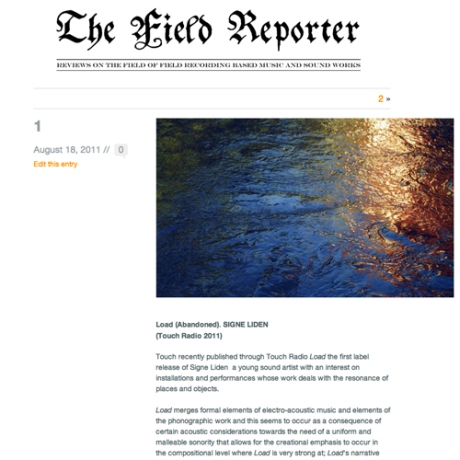

untitled. ANNA PLANETA
-Andy Jarvis, Joincey, Mikarla Jarvis, Phil Todd-
(Betley Welcomes Careful Drivers 1998)
I can’t remember the exact year, but I was working at a large hospital in Nottingham, England and living in a tiny room in the staff accommodation block. I had a lot more time to listen to music in those days. I found myself forever searching for something, something I hadn’t heard before that didn’t involve tired old electric guitars, synthesizers and drums and that came from somewhere else. I didn’t know what it was, yet I felt sure I’d know when I found it.
In order to stay plugged into the matrix of truly incredible music that was filtering through from New Zealand at the time (SEHT, Surface of the Earth, RST, Dead C, Flies Inside the Sun etc.) I was sitting on the bed reading through a printed distribution catalogue that dealt in such strangeness. It was before everything went internet and paper still existed. The catalogue was from Fisheye distribution and contained hundreds of descriptions of exotic and beautiful sound artefacts, but one in particular caught my imagination.
Recorded at a derelict boarding school called Cotton College, near Alton Towers in Staffordshire, Anna Planeta was a double CD released on the wonderfully titled Betley Welcomes Careful Drivers label. I think part of the write-up alluded to the fact that the label considered this release tantamount to commercial suicide. Obviously I sent off the cash and in due course a small package appeared in my pigeon hole in the communal post room.
The two CDs came in a rough cardboard envelope with a black, fairly indistinct print of a photograph of something dark and closed in. I was shocked to find that the ink was actually water soluble. If you wet your finger and rub it a bit you can smudge it, thus adding a new layer of consumer participation to the packaging design. Surely a concept that calls for further exploration?
Anna Planeta were Dan Bird, Andy Jarvis and Phil Todd, who ran the record label and also operated under the name Ashtray Navigations. Clutching their battery operated and acoustic instruments, they entered this dilapidated, abandoned school building and proceeded to interact with the fabric of the space. The result is a compelling document of what could be a ritual to tease ghosts from out of the masonry.
Although instruments play a part, they never detract from the location. The central characteristic of these recordings is the sense of an empty, debris strewn interior. Particularly on the two long tracks that comprise disc one, the musicians work with their surroundings as a resonating chamber and never fill the emptiness. It is always left to ring and echo down corridors and long disused classrooms.
The track titles in themselves serve as indicators of mysterious depths: The Galley, Our Lady Carbonate, Flowerfruit of Life, The Creak in the Wood, Bleakest Tea Bottle, and of course the classic S. Freud, C.G.Jung and W. Reich Cast Wide Along the Oedipal Axis. The latter being the noisiest track of the lot and a pretty speaker wrecking finale.
So finding Anna Planeta was a revelation to me. Playing these tracks late at night, with their extremely quiet passages of gentle creaks and groans suddenly punctuated by loud, percussive crashes, I started to think that places as well as events could be recorded. Atmosphere and the personality of a location could be conveyed in sound waves as well aspictures and text. I wanted to start a bit of self-education, and a door into the classroom had just swung open.
Phil Todd has a few copies of this still available, some of the tracks can also be previewed on YouTube. Unfortunately it seems to be no longer available as a download, but who knows what might happen in the future? Maybe it’ll be conjoured up into the realm of the perceptible once more so we can all enroll into the academy of dark vibrations again.

[CD images and booklet reverse art work, courtesy of Discogs]
-Chris Whitehead
Anna Planeta discography
Betley Welcomes Careful Drivers discography

Prairie. D’INCISE
(Obs 2012)
The genre of drone music has found a powerful voice in Swiss composer D’incise. During the past decade he has worked on several releases that have pushed this hypnotic medium into new territories. The latest release from d’incise, “Prairie”, continues this exploration of the minimal, stretching field recordings of various objects beyond their original forms, transforming them into unrecognisable sounds with their own tonal and emotional resonance.
“Prairie” is a four-track release split over 2-cds. Each track is quite lengthy, ranging from twenty-five minutes to one hour. Over the duration of three hours the listener is presented with subtle layers of sound that slowly weave around each other in a darkly atmospheric way. One of the pleasures of “Prairie” is listening beneath the swirl of drones, where a plethora of minute sounds is revealed.
“Prairie” demonstrates a highly creative process behind each track. “What’s wrong with a cowboy in Hamburg” features the harmonic vibrations of a drum skin, whilst “Amplification of a number of points supposedly worthless” features the magnification of quiet moments at a number of concerts. Recordings of nails, plastic boxes, feedback, and domestic sounds are also included to add depth to the tracks.
As with most forms of drone music the compositions sit comfortably in the background, the subtly layered tones fading in and out of the listener’s consciousness. However listening attentively through headphones provides a much more rewarding experience. D’incise knows how to use stereophonic effects to their fullest potential, with miniscule crackles and bleeps moving steadily between one ear and the other. It is through this act of listening that we realize the multi-layered complexity that exists in his work. Drone music, often accused of being too simplistic or monotonous, is shown in “Prairie” to be a highly elaborate construction. A sense of tension exists in “Prairie”, as the listener’s attention is manipulated between the background and foreground of the compositional elements.
In modern musical discourse drone music is often reduced to the label of “stoner rock”, yet this terminology shows a disregard to its historical lineage and present day intent. Drones can be traced back thousands of years to the mesmeric sound of the Australian Aboriginal didgeridoo, and in the religious music of medieval European music. As with contemporary drone music these ancient cultures utilised dense and slowly evolving harmonies to subconsciously still the listener’s sense of time, enabling us to leave the external world and travel inwards. This approach is in opposition to today’s modern music that relies upon fast editing, big beats and anthemic build-ups; a point alluded to by d’incise in his liner notes stating “when it gets boring it becomes interesting”.
“Prairie” can be played as both an ambient record or as something to be listened to much more attentively. My suggestion is to put on a pair of headphones, turn off the lights and allow yourself to be moved by the deeply meditative tones of d’incise.

[D'Incise, photo author Robin Parmar -all rights reserved-]
-Jay-Dea Lopez
D’Incise website
Obs website
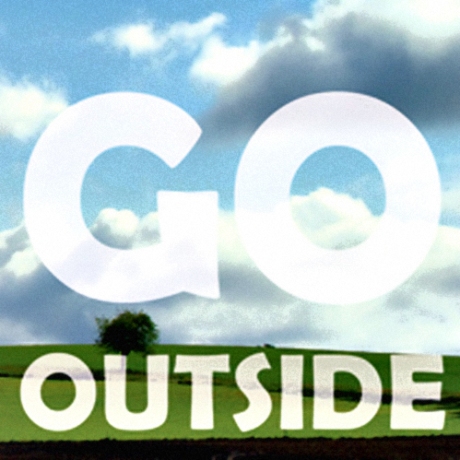
Go Outside. ROBERT CURGENVEN
(Kaon 2012)
Dernière parution de la série initiée par Cédric Peyronnet autour de ses enregistrements de la rivière du Taurion, c’est au tour de Robert Curgenven de travailler à partir de cette matière sonore.
L’artiste joue de la rivière comme on branche une guitare dans un rack d’effets et repousse les méandres aquatiques dans leurs derniers retranchements.
De l’eau vrombissante il en extrait la plus petite particule, un bruit blanc, comme un quark soumis à une excitation. Il rassemble ensuite ces éléments primordiaux dans un ordinateur défectueux, des logiciels soumis aux lois du hasard, les ressort dans une boucle analogique d’effets et de bandes magnétiques, joue sur la dynamique et passe du très fort au très infime.
Loin de la canaliser, Robert Curgenven libère la fougue de la rivière, la fait sortir de son lit, et littéralement le titre du disque, Go Outside, résonne chez l’auditeur comme un appel, à sortir de son propre lit, aller dehors et vivre ce qui s’y passe.
On est bien loin de certains artistes à l’humeur sombre chez qui l’eau peut se changer en liquide pesant, du vin ou de la boue, ici l’on fait face à plus qu’un changement d’état, on est saisi dans un flux de pure énergie où la rivière pourrait tout aussi bien être une fée électricité, apte à quitter le domaine de la navigation pour se répandre dans la ville, lumière qui nous entoure, continuation urbanisée de ce qu’elle était auparavant dans son milieu naturel.
Ultime écho à sa performance, Robert Curgenven précise que le mixage et le montage ont été réalisés vers l’estuaire de la rivière Fowey dans les Cornouailles, comme un geste en miroir à la source originelle captée dans le Limousin, on se surprend dès lors à imaginer chez lui le besoin d’être dans les environs de cette autre rivière, comme une présence nécessaire à l’élaboration de son oeuvre, au plus près de l’eau, presque dans l’intimité de son lit.
-Flavien Gillié

[Robert Curgenven]
(Translation to English)
Latest release in a series initiated by Cédric Peyronnet around his Taurion river’s recordings, Robert Curgenven is now ready to (re-)work this sound matter.
The artiste plays the river as a guitar plugged in an effects rack and repells aquatic meanders in their corner. Out of humming water, he extracts the smallest particle, some white noise, like an excited quark. Then he assembles these primal elements into a defective computer with random-driven softwares, outputs them in an analog loop of effects and magnetic tape, jockeys the dynamics, from the very loud to the very intimate.
Far from canalizing it, Robert Curgenven unleash the ardour of the river, takes her out of her riverbed, and literally, the title of the disc “Go Outside” is a call for the listener to get out of it’s own bed, and go outside, see and live what is going on there.
Here, we are not in the same mood as some artists, that could turn water in some burdensome liquid, wine or mud, no definitely not, as one faces here more than a change of state, one is trapped in a flux of pure energy while the river could be the Fairy Electricity as well, able to exit the navigation domain to spread out in the city, surrounding light, urban continuation of what she was before in her natural locus.
Final echo to it’s performance, Robert Curgenven states that mixing and editing were realized around the Fowey river’s estuary, Cornwall, as a mirror gesture of the original source captured in the french area Limousin, surprisedly one imagines his need to be in the surroundings of this other river, as a necessary presence to the birth of his opus, the closest to the water, in the near intimacy of her (river) bed.
-Flavien Gillié, translation by Sismophone
Robert Curgenven website
Kaon website

Thief. LANCE AUSTIN OLSEN
(Infrequency 2012)
Above all, originator of strong abstract visuals, Lance Austin Olsen has gradually curled up into the hank of sound experimentations… Here, from a despicable tabloid event, and the definitive evaporation of a section of his personal archives due to a burglary, he mutates this traumatic experience into an introspective throbbing soundtrack… Long sizzling layer of rubbings, of slowed down, dusty, fogged sounds… subterranean world in dismay, reflection of an obscure side, link onto a mistreated unconscious, a torn to pieces memory… As a painter, he proceeds by assemblage of small dashes, and grouping of sound incidences till forming in the end a disturbing audio-montage close in spirit to Eraserhead… Last sighs of outdated equipment, round dance of dazed steps on lost paths, difficult breathings, metaphorical jolts of machines in distress… Lance Austin Olsen, through a dreamlike subterfuge, exorcizes his fears, his anger, and makes us slide into a grim universe, a kind of hidden groove, a grey blurred surface whom bumps peep out, and whom thick mystery excites our imaginary like so many spectral charcoal strokes…a backdoor onto the darkness of stolen moments, though recovered by the grace of a saving creative gesture…
“Thief” far more than the narration of a plundering forms part of a brilliant attempt of restitution, of self peace…a cure to recommend against these ambient evil things which threaten with wearing down our lives…
A totally fascinating work, besides free as its download…
-Daniel Crokaert

[Lance Austin Olsen courtesy of Fluid Radio]
(French version)
Avant tout, auteur de puissants visuels abstraits, Lance Austin Olsen s’est progressivement lové dans l’écheveau des expérimentations sonores… Ici, à partir d’un odieux fait divers, et de l’évaporation définitive d’un pan de ses archives personnelles suite à un cambriolage, il mute cette expérience traumatisante en lancinante bande son introspective… longue nappe grésillante de frottements, de sons voilés, ralentis, poussiéreux… monde souterrain en désarroi, reflet d’une face obscure, passerelle sur un inconscient malmené, une mémoire désormais en lambeaux… A la manière du peintre qu’il est, il procède par accolage de petites touches, et groupement d’incidences sonores jusqu’à former au final, une piste sonore troublante qui n’est pas sans rappeler l’esprit d’Eraserhead… Derniers soupirs de matériel vétuste, ronde de pas hébétés sur des sentiers perdus, respirations difficiles, soubresauts métaphoriques de machines en détresse… Lance Austin Olsen, par un subterfuge onirique exorcise ainsi ses peurs, sa colère, et nous fait glisser dans un univers glauque, une sorte de sillon masqué, une surface floue et grise dont les aspérités se laissent deviner et dont l’épais mystère fouette notre imaginaire comme autant de traits spectraux au fusain…une porte dérobée sur la noirceur de moments volés, mais récupérés par la grâce d’une geste créatif salvateur…
“Thief” bien plus que la narration d’une spoliation s’inscrit comme une brillante tentative de restitution, de paix avec soi-même…une remède à préconiser contre ces maux ambiants qui menacent de ronger nos vies…
Une oeuvre totalement fascinante, libre comme son téléchargement d’ailleurs…
-Daniel Crokaert
Lance Austin Olsen website
Infrequency website
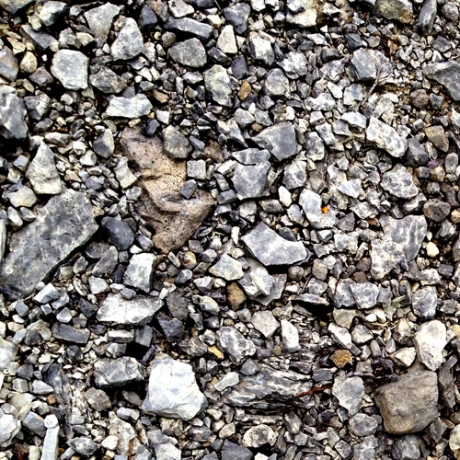
Ossenfeld. GERÖLLGERÄTE
(self release 2012)
Phonographic works that concentrate on a particular type of sound are by no means uncommon. Rivers, waves, rainfall, birdsong, deer, whales and insects are just a few examples of recording subjects that have been the focal point of many a release. ‘Ossenfeld’, from Christoph Petermann and Hardy Küster, climbs a few more steps up the esoteric ladder by presenting the listener with a 30 minute piece dedicated to the infinite sounds of stones.
Few details are available about the content or context of the work; other than the title, location details and the one line description ‘explores the sounds of stones’, we are left with nothing other than the actual sound. Perhaps this was deliberate; with no written information to aid us, our full attention is transferred onto the audio where we can try to glean as much information as possible from the sounds put in front of us.
There is certainly something captivating about ‘Ossenfeld’. The recording quality is first class and the sounds, recorded in a quarry in Germany, are so clear and crisp that you can almost visualize the recordists at work, experimenting with different movements and textures.
This publication is not just a stone fest though – tune your ears into the background and you will be rewarded with glimmers of birdsong. A Yellowhammer plaintively asking for “A little bit of bread and no cheese”, an overhead Skylark showering the quarry with its unbroken song, cawing crows and other nearby birds add a biological element to this work.
I admire Petermann and Küster’s embrace of the esoteric. To create a piece that is dominated by the sounds of stones in a quarry could not be described as anything else. It illustrates the desire of field recordists to constantly explore new sources of sound and not shy away from those topics that may be considered to lie outside the “norm”.
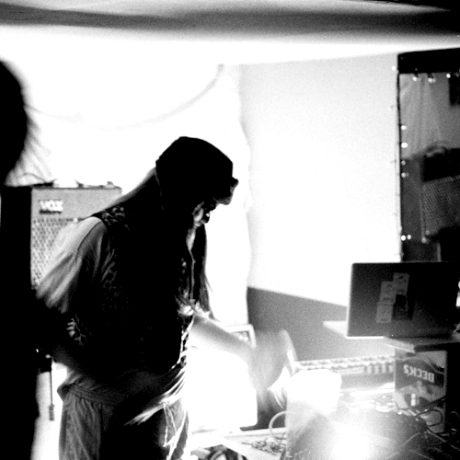
[Christoph Petermann, photo: Utku Tavil]
-Cheryl Tipp
Christoph Petermann discography
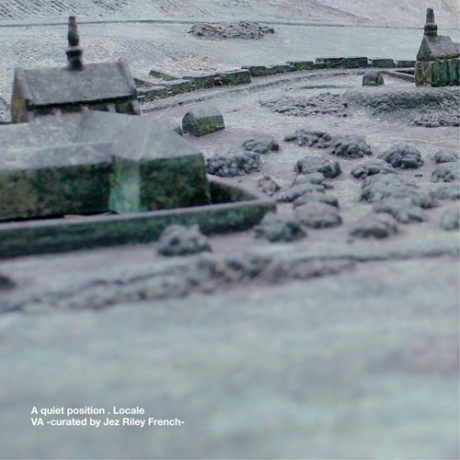
A Quiet Position. VA – curated by Jez Riley French-
(Impulsive Habitat 2012)
“A Quiet Position” is a sublime new release of field recordings poetically capturing the subtle sounds that exist in common areas. Curated by Jez riley French “A Quiet Position” showcases the way in which field recordings meditatively transport us into the present moment, where the passage of time exhibits an elasticity that cannot be found in another art medium.
“A Quiet Position” features nine field recordists from a diverse range of countries including England, Iceland, Norway, and Japan. Despite differences in regions “A Quiet Position” is unified through each field recordist’s approach to their subject. Sounds which quietly envelope us are amplified, placing the miniatures of life into a more prominent stance. Any amplification is done with absolute sensitivity, without endangering the delicate quality of the sounding object or its environmental context.
Each of the tracks in “A Quiet Position” offers something unique for the listener, however for the limited space of this review only a few standout tracks will be mentioned. The first of these is by Jez riley French. “An Upstairs Landing” features the sound of air reverberating inside a glass jar. By using lavalier microphones French captures an otherworldly tone slightly reminiscent of recordings of the sun’s electro-magnetic energy. There in his room in Cambridge French reveals a sound that could be easily dismissed by those without the patience to fall into its sense of wonder.
Duncan White’s recording titled “Array no.13” illustrates the variations that exist in the tone and pitch of wind. Recorded at Rampisham Transmission Centre in the summer of 2011 White’s track embodies the way in which R. Murray Schaffer described the musicality of the world around us. It exudes a sense of timelessness and isolation that is slowly unveiled to those who close their eyes to listen.
“Hitre” by Signe Liden is a deceptively simple composition made by layering field recordings of a bridge squeaking with the movement of waves on a Norwegian island. In the distance wolves can be heard, adding spatial depth and a haunting tone to the work. “Hitre” effectively demonstrates the way we respond to quiet sounds and the use of silence. By listening to the quiet that surrounds us we become more attuned to the spaces in which we live.
Running at just over fifteen minutes Elin Oyen Vister’s recording of a dawn chorus in Iceland’s Ytribaer Forest is “A Quiet Position’s” longest and most straightforward track. “Ytribaer Forest” brings the uninitiated listener close to the experience of traditional field recording. Listening to the quiet warbling call of the male Common Snipe in Vister’s recording is a pleasant challenge that confronts our ever-diminishing ability to slow down. Entrenching ourselves in the sounds of the early morning forest we are absorbed into “the moment”, our sense of time realigns itself with the natural flow. It is this serene connection between sound and time that is the common thread between each of the ten tracks in “A Quiet Position”.
Jez riley French has successfully curated a collection of works by field recordists who allow us entry to their sonic discoveries. The recordings were taken in regions we may never visit, however they are from acoustic spaces available to everyone. Recordings presented in “A Quiet Position” open us to the sonic possibilities of everything from bottles, trains, kerosene heaters, and bird nests. Familiar objects and places lie before us in quiet positions. It is our task to open our ears and listen.

[Jez Riley French]
-Jay-Dea Lopez
A quiet position project website
Impulsive Habitat website
 Songs of the Humpback Whale. ROGER PAYNE
Songs of the Humpback Whale. ROGER PAYNE(Capitol 1970)
‘Songs of the Humpback Whale’ can be seen as a milestone in the history of published field recordings. Firstly, this double sided LP made available the first commercial recordings of Humpback Whale vocalisations. Secondly, the LP was released by major American Label, Capitol Records, who were (and still are) most usually associated with leading musical artists of the day.
The man behind this record was Dr Roger S. Payne, a Harvard and Cornell Graduate who decided to study whales in the 1960s without ever actually seeing one. Together with his colleague, Scott McVay, Payne discovered that male Humpback Whales use “songs” during the breeding season to communicate. The term “song” was chosen because, as with birdsong, Humpback Whale song consists of long, complex sequences of phrases that are repeated over time. This breakthrough resulted in many hours of recordings that, as well as identifying the use of song in Humpback Whale society, also showed that these songs were actually changing over time, with new elements being incorporated from one year to the next. In addition, it was found that these changes were accepted and adopted by all males within a population, thus the collective song would always evolve along the same path for a given group of whales.
The 1970 LP sought to share these acoustic discoveries with a wider audience. ‘Songs of the Humpback Whale’ gave listeners the opportunity to experience a range of different hydrophonic recordings of whale song. When listening to the selection and arrangement of the tracks, you start to get a real sense of Payne’s love and empathy for this amazing mammal. Most recordings are several minutes in length, allowing the listener ample time to appreciate the beauty of these vocalisations. Side Two is dedicated to a 16 minute long track entitled ‘Three Whale Trip’, recorded near the coast of Bermuda at a favourite listening spot of his. Payne wrote in the sleevenotes:
“As you listen to this recording, I wish only that it could convey to you the pleasant circumstances under which we made it. Through the whole night we listened to the whales, taking turns at the headphones in the cockpit, lulled by the smooth rolling of the boat. Far from land, with a faint breeze and a full moon, we heard these lovely sounds pouring out of the sea.”
In January 1979, National Geographic included a flexidisc in their magazine featuring recordings from Payne’s personal Humpback Whale collection. The magazine pressed a staggering 10 and a half million copies, which is still the largest single pressing of a commercial record. In his accompanying article, Payne wrote about an evening out at sea:
“Often during that night off Bermuda I thought how the oceans had once heard these wild cries. How, once, the echo chambers of the sea had reverberated to the haunting “songs” of whales. Then I thought of what it is like today in many of the whales’ former haunts – silent, lifeless, impressing one most with a sense of what has been lost.”
His scientific work with Humpbacks led Payne to become an important figure in the international campaign to end commercial whale hunting. Conservation and protection of our marine environments became another passion, leading him to found the organisation Ocean Alliance. Payne said in his 1979 National Geographic piece:
“Our belated concern for whales is helping to save them from extinction by commercial hunting, but how are they to survive if we destroy the oceans themselves. Pollution has replaced the harpoon as a mortal threat to whales, and in its way can be far more deadly. If we ignore the dangers of tanker spills, industrial contamination, and human carelessnesss, then nothing can save the whales. If that day ever comes, the exquisite songs you hear on this sound sheet will be voices not from the sea, but from the past.”
This poignant statement can be applied to many other species that are currently under threat from the activities of mankind. How sad is it when the only way to hear an animal’s voice is on a commercial publication or through a sound archive? Unfortunately this is the case for some species already lost to us, but with the dedicated efforts of scientists, conservationists and environmentalists, the library of vanished voices will, hopefully, cease to grow.

[Roger S. Payne]
-Cheryl Tipp
Roger S. Payne on Wikipedia
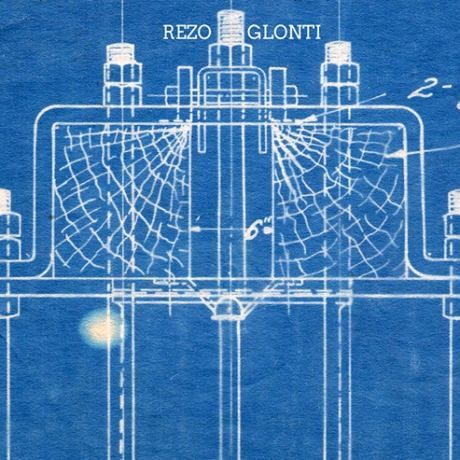
The Diary Of The Second Officer. REZO GLONTI
(Time Released Sound 2012)
Une telle musique peut faire vaciller l’âme.
L’artiste géorgien Rezo Glonti distille ici de savoureuses mélodies ambiantes intimement mêlées à des parcelles sonores, ses souvenirs ou ceux de son double imaginaire, officier en second d’un monde longtemps parcouru, puis rassemblé sur ces douze plages.
Les titres sont des lieux ou des déplacements, des rencontres toujours, l’album est résolument ouvert sur le monde, on n’aime guère les comparaisons car elles sont réductrices, mais ici on voudrait les écrire, pour donner à ce disque une place d’importance, parler des premiers Biosphere ou Black Dog, en un sens plus large évoquer des musiques mythiques, bouleversantes.
On ressent chez Rezo Glonti une introspection nécessaire à l’élaboration de l’oeuvre, entre le corps et l’étreinte du corps, le début d’une parole dans le jardin botanique de Batumi, un sanglot peut-être. La rigueur mécanique du temps implose, l’espace s’ouvre sur un monde à la fois silencieux et infiniment dense, le capitaine s’efface et l’officier en second accepte alors son destin, non pas celui de se faire comprendre, mais bien plutôt celui de faire saisir ce qui ne peut être entendu dans le langage quotidien.
L’album, lit-on au dos du disque, a été composé avec une installation minimale, un petit clavier midi, un magnétophone de poche, un ordinateur portable et un casque. Un matériel accessible à tout artiste, mais bien peu seraient à ce point capables d’en donner à entendre ce spectacle primordial que l’on ne se lassera pas de contempler de si tôt.
-Flavien Gillié

[Rezo Glonti, photo author Ani Chorgolashvili]
(Translation to English)
Such music can topple the soul.
The georgian artist Rezo Glonti sprinkles us with delightful ambient melodies intimately combined to sonic chunks, his memories or those of his imaginary doppelgänger, second officer of a widely wandered world, then distilled into these twelves tracks.
Titles are places or trips, encounters always, the album is resolutely open to the world; one hardly likes comparisons as they are reductive, but would definitely write them anyways, to give this disc a greater extent, mention the first Biosphere’s or Black Dog’s, in a wider sense evoke mythic moving musics.
One feels in Rezo Glonti’s sounds an introspection necessary to the opus elaboration, halfway between body and embrace, a very first word in Batumi’s botanic garden, a weep maybe. The rigorous mechanics of time implodes, space opens on a silent world as well as infinitely dense, the captain disappears and second officer acknowledges his fate, not the fate to be understood, but rather to make others aware of what cannot be heard in daily language.
The album, as stated on back cover, was composed with a minimal setup, a small midi keyboard, a pocket tape recorder, a laptop computer and headphones; everything truly available to any artist, although very few would (like him) extract of it this primeval spectacle whose contemplation we are not nearly to be fed up with.
-Flavien Gillié, translation by Sismophone
Rezo Glonti website
Time Released Sound
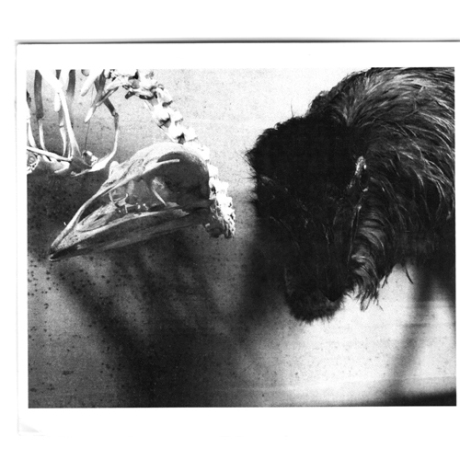
A while and awhile. FRANCISCO MEIRINO
(Obs 2012)
I have seen a photograph of an open case which is absolutely stuffed full of black cables and wires. Next to these is a metal box with eleven knobs on, each one turned to a different setting. At the side of this case, hanging from a drumstick projecting from the top of a reel-to-reel tape recorder, are several magnetic tape loops. These items belong to Francisco Meirino, and if ever anyone needed an illustration of what ‘A while and awhile’ might sound like, they need look no further.
Meirino seems to be using two categories of sound here: The physical ( flicking switches, starting fans, clanking metal and generally shuffling around ), and the electrical ( low hums, sparky crackles, overloaded circuits and the sound of fingers on jack plugs ). From this palette he blends pinpoint clicks and sub-bass rumbles with everything in between and comes out with a constantly changing and evolving music of chance encounters.
The first of the nine tracks for example, unnamed except for its length of duration ( 4.51 ), begins with sounds that might be generated in one’s mouth. Spittle snaps and pops in a salivary display of crepitation. Beneath this a deep, ominous hum takes shape and begins rising from nothing. Before long other mysterious activity, as if from far off rooms carried down ventilation shafts and bounced off walls, becomes apparent.
We’re located in a no-man’s land where it is hard to get a grasp of the location. This is certainly a physical world, but power surges and badly soldered electrical components are rendering the infrastructure dangerous. I see from his website that Meirino has a preference for performing live in absolute darkness. I can visualise the air around him igniting and glowing in iridescent flashes as charged particles collide and decay.
The term ‘glitch’ is an ugly word, and it seems to have been taken on board by a generation of electronic artists wanting to disrupt the metallic sheen of computer music with carefully placed flecks and meticulously honed cuts. Mereino’s work should not be confused with self-conscious confections of this nature. His art paints a raw and unpolished landscape with surprises and danger at every turn.
His music explores the tension between programmable material and the potential for its failure. Track 8 puts me inside a computer, but not in a digital way. Not in the sense of being incorporated into the programme as data like Tron. Instead I’m among the fans that cool the processor. I can hear the data transfers occurring via the wires and I can sense the power coming in from the mains, but it’s all so poorly insulated that energy is leaking out at random points. Instability is increasing. Help!
‘A while and awhile’ is awash with forces and potentials pulling in all directions. Meirino has developed a purely personal way of articulating his chosen material, and in doing so has created a compelling and completely enthralling piece of work. If this becomes your introduction to this artist, as it was mine, you will want to explore more and search out further examples. Believe me, naked electricity is positively addictive.
I would like to end this review with a piece of advice: Never let Francisco Meirino rewire your house!

[Fransisco Meirino, photo from his website]
-Chris Whitehead
Fransisco Meirino website
Obs website